Gothic Locks: Pioneering Drawings for Hydraulic Works in 16th-Century Holland
Abstract
1. Introduction
2. Gothic Masters in the Renaissance
3. The Consequence of Architectural Drawings in the Low Countries
4. Drawings and Models for Stone Locks
5. Building a Stone Sluice at Halfweg
6. Drawings for Halfweg
7. A Graphic Parts List for Stone
8. Detail Drawings
9. Conclusions
Funding
Data Availability Statement
Acknowledgments
Conflicts of Interest
| 1 | A similar development can be discerned in 15th- and 16th-century Italy. Schlimme et al. (2014, p. 325). |
| 2 | Ottenheym and De Jonge (2007, pp. 93–96). Little is known about Mockaert, before he entered into the service of the Brabantine court in 1556, but he supplied stone for the Coudenberg Chapel in 1552. Archives générales du Royaume, Brussels, Chambre des Comptes, 4255, f. 180v. and Archives générales du Royaume, Brussels, Cartons, 132a. See also Roobaert (2004), 26. And in 1550 he was one of the expert advisors on the design of the Coudenberg Chapel, while also later he was consulted for the Antwerp Town Hall in 1564, for which he also had supplied pilasters two years earlier. Adriaenssens (1980, pp. 123–42) and Hurx (2023b, pp. 20–21). |
| 3 | Dodt van Flensburg (1843, vol. 3, p. 249). His father already provided a design in 1535 and in 1553, however works only began after a new drawing was made by Heinric. Dodt van Flensburg (1843, vol. 3, pp. 217 and 229). |
| 4 | … een van de beste Meesters in Hollandt van deze Conste te wesen die gelijcke wercken wel gemaict heeft… Thijssen (2001, p. 7). |
| 5 | Willem van Noort was appointed as stads-metselrie-meester in 1540. Dodt van Flensburg (1843, vol. 3: p. 220). |
| 6 | …overmidts dien datmen egheene sulcke wercken gemaken en can, ten sy datter yerst ennich beworp oft patroon af geordineert sij, daer na men die wercken mach (one cannot erect such a construction, unless there is devised some sort of design or pattern, after which the work can be made…). Hurx (2018, p. 43). |
| 7 | A typical category of combined drawings is that of sacrament houses. Such drawings have been preserved in the German world from the 15th and early 16th century in substantial numbers. Böker (2005, p. 25). Also in Britain the combination of plan and elevation was known, see: Gerbino and Johnston (2009, p. 30). |
| 8 | …omme te onderzoucken den grondt ende de bequaeme gelegenth. vandien ende alle tzelve by geschrifte gestelt mitsgaders noch aldaer gemaect ende ontworpen eende charte ende patroon daer naer men de voors. sluse zoude mog. funderen ende dat gedaen wesende miter zelve besoingne weder gereyst ind Hage. OAR, 1.1.1, inv. no. 9578, f. 463r.-v., and …ghemaect heeft een grondt ende besteck in pouirtracture van de zelfve sluse… OAR, 1.1.1, inv. no. 9578, ff. 603r.-604r. |
| 9 | In 1557, Fredericxz was paid for een cairte van die gheleghentheyt van de sluse in de groote wale… while also the painter Roeloffs received payment for a map in July 1557, which was referred to in almost the same words …cairte vande gelegentht. vande sluys inde grote waele met hoeren tochten ende aenwateringhen... OAR, 1.1.1, inv. no. 9578, f. 19r. and f. 610v. Possibly they worked together on the same map. See also Van Amstel-Horák (1994, p. 49); Diebels (1986, pp. 19–21). |
| 10 | OAR, 1.1.1, inv. no. 21, f. 18r. The initial the estimated cost of July 1556 was 6000 pounds (of 40 groats Flemish). OAR, 1.1.1, inv. no. 21, f. 19v. See also Van Amstel-Horák (1994, p. 62). |
| 11 | …berderen ende winckelhaicen dair Mr. Cornelis de boochstucken heeft doen nae houden… OAR, 1.1.1, inv. no. 9579d. See also OAR, 1.1.1, inv. no. 9578, f. 201v. |
| 12 | Cornelis Velsen, Tekeningen, vande Rhynlands sluysen. gelegen by 't Huys te Zwaanenburg. of vande reparatie aan dezelve gedaan inde jaaren 1725, 1726, en 1727, 1727. OAR, 1.1.1, inv. no. 30A Kaarten en technische tekeningen. See Van Amstel-Horák (1994, p. 69). |
| 13 | Folio A 605 explains that the west side is marked with a “+”: Item dese laech is hoech, 1 ¼, voet ende is gheteikent aldus mit, 1 2 3 4 5 6 7 8 9 10, ende die west sijde met een, +, ende staedt bij die owe sluijs anden dijck. |
| 14 | The height of each course seems not to correspond to sizes mentioned on the elevation drawing A 595. |
| 15 | …een lage steens lager wesen zoude dan twulfsel aen de meer zyde… 9. OAR, 1.1.1, inv. no. 9578, f. 451r. and f. 456v. |
| 16 | For instance, the blue limestone copings were contracted out following the templates of Fredericxz: navolgende de voors. barderen ofte patroonen. OAR, 1.1.1, inv. n0. 9581a. |
| 17 | …daer meester Cornelis de boochstucken heeft doen nae houden… OAR, 1.1.1, inv. no. 9578, f. 201v. |
| 18 | The archaeological excavation was done by Vestigia B.V., who gave me access to the site in 2021. My thanks goes to Jeroen Flamman who discussed the excavations with me. |
References
Primary (Written) Sources
Archives générales du Royaume, Brussels,.Cartons, 132a.Chambre des Comptes, 4255.Nationaal Archief, The Hague, Grafelijkheidsrekenkamer, 5008.Hoogheemraadschap van Rijnland, Leiden, Oud Archief van Rijnland, Leiden (OAR), 1.1.1,.inv. no. 21; 4856; 9578; 9579d; 9581a.inv. no. 30A, Kaarten en technische tekeningen.Secondary Sources
- Ackerman, James. 2002. The Origins of Architectural Drawing in the Middle Ages and Renaissance. In Origins, Imitation, Conventions: Representation in the Visual Arts. Edited by James Ackerman. Cambridge: MIT Press, pp. 27–65. [Google Scholar]
- Adriaenssens, R. 1980. Sur l’hôtel de ville d’Anvers et les apports des carrières wallonnes dans son édification. Bulletin de la Commission Royale des Monuments et des Sites 9: 123–42. [Google Scholar]
- Amstel-Horák, Marleen van. 1994. Nieuwbouw van twee sluizen in een benarde tijd: Halfweg 1556–1558. In Zeven eeuwen Rijnlandse uitwatering in Spaarndam en Halfweg. Van beveiliging naar beheersing. Edited by Ludy Giebels. Leiden: Uitgeverij Verloren, pp. 47–74. [Google Scholar]
- Arends, G. J. 1994. Sluizen en Stuwen. De ontwikkeling van de sluis-en stuwbouw in Nederland tot 1940. Utrecht: Matrijs. [Google Scholar]
- Berg, Bianca van den. 2008. De Sint-Janskerk in Gouda. Een oude stadskerk volgens een nieuw ruimtelijk plan. Hilversum: Uitgeverij Verloren. [Google Scholar]
- Berg, Herma van den. 1963. Hollandse en Nederrijnse invloeden in de XVde en XVIde eeuwse bouwplannen van de St. Maartenskerk te Tiel. Nederlands Kunsthistorisch Jaarboek (NKJ)/Netherlands Yearbook for History of Art 14: 1–25. Available online: http://www.jstor.org/stable/24705295 (accessed on 1 May 2024). [CrossRef]
- Böker, Johannes. 2005. Architektur der Gotik. Bestandskatalog der weltgrößten Sammlung an gotischen Baurissen (Legat Franz Jäger) im Kupferstichkabinett der Akademie der bildenden Künste Wien/Gothic Architecture. Catalogue of the World-Largest Collection of Gothic Architectural Drawings (bequest Franz Jäger) in the Collection of Prints and Drawings of the Academy of Fine Arts Vienna. Salzburg and Vienna: Verlag Anton Pustet Salzburg. [Google Scholar]
- Böker, Johannes, Anne-Christine Brehm, Julian Hanschke, and Jean-Sébastien Sauvé, eds. 2011. Architektur der Gotik. Ulm und Donauraum. Ein Bestandskatalog der mittelalterlichen Architekturzeichnungen aus Ulm, Schwaben und Donaugebiet. Salzburg and Vienna: Müry Salzmann. [Google Scholar]
- Böker, Johannes, Anne-Christine Brehm, Julian Hanschke, and Jean-Sébastien Sauvé, eds. 2013. Architektur der Gotik. Rheinlande. Salzburg: Müry Salzmann. [Google Scholar]
- Bork, Robert. 2011. The Geometry of Creation. Architectural Drawing and the Dynamics of Gothic Design. Farnham and Burlington: Routledge. [Google Scholar]
- Bork, Robert. 2014. Dynamic Unfolding and the Conventions of Procedure: Geometric Proportioning Strategies in Gothic Architectural Design. Architectural Histories 2: 1–20. [Google Scholar] [CrossRef]
- Chisholm, Michael. 2005. Locks, Sluices and Staunches: Confusing Terminology. Transactions—Newcomen Society for the Study of the History of Engineering and Technology 75: 305–16. [Google Scholar] [CrossRef]
- Coenen, Ulrich. 1990. Die spätgotischen Werkmeisterbücher in Deutschland. Untersuchung und Edition der Lehrschriften für Entwurf und Ausführung von Sakralbauten. Munich: Scaneg. [Google Scholar]
- Dam, Petra van. 1994. Spuien en heien. Innovatie en de rol van de stedelijke elite bij sluisbouw te Spaarndam in de 15de eeuw. In Zeven eeuwen Rijnlandse uitwatering in Spaarndam en Halfweg. Van beveiliging naar beheersing. Edited by Ludy Giebels. Leiden: Uitgeverij Verloren, pp. 47–74. [Google Scholar]
- Dam, Petra van. 2002. Ecological Challenges, Technological Innovations: The Modernization of Sluice Building in Holland, 1300–1600. Technology and Culture 43: 500–20. [Google Scholar]
- De Jonge, Krista. 2007. Part One. The First Reception of the Antique. In Unity and Discontinuity. Architectural Relations between the Southern and Northern Low Countries 1530–1700. Edited by Krista De Jonge and Konrad Ottenheym. Architectura Moderna 5. Turnhout: Brepols, pp. 15–86. [Google Scholar]
- De Jonge, Krista. 2014. Early Modern Netherlandish Artists on Proportion in Architecture, or ‘de questien der Simmetrien met redene der Geometrien’. Architectural Histories 2: 1–23. [Google Scholar] [CrossRef][Green Version]
- Diebels, P.G.M. 1986. Hoogheemraadschap van Rijnland Archieven. Beschrijving van de oudste kaarten, 1457–1580. Leiden: Unpublished inventory. [Google Scholar]
- Dodt van Flensburg, Johannes Jacobus. 1843. Archief voor kerkelijke en wereldsche geschiedenissen, inzonderheid van Utrecht. Utrecht: Van der Monde, vol. 3. [Google Scholar]
- Duverger, Jozef. 1964. De architect Philip Lammekens ca. 1493–1548. In Opus musivum, een bundel studies aangeboden aan Professor Doctor M.D. Ozinga ter gelegenheid van zijn zestigste verjaardag op 10 november 1962. Edited by Henri van der Wyck, Cornelis Boschma and Herma van den Berg. Assen: Van Gorcum & Comp, pp. 181–89. [Google Scholar]
- Gerbino, Anthony, and Stephen Johnston. 2009. Compass and Rule: Architecture as Mathematical Practice in England 1500–1750. New Haven and London: Yale University Press. [Google Scholar]
- Gerritsen, Elske. 2006. Zeventiende-eeuwse architectuurtekeningen. De tekening in de ontwerp-en bouwpraktijk in de Nederlandse Republiek. Zwolle: Waanders. [Google Scholar]
- Hecht, Konrad. 1979. Maß und Zahl in der gotischen Baukunst. Hildesheim and New York: Olms. [Google Scholar]
- Hurx, Merlijn. 2018. Architecture as Profession. The Origins of Architectural Practise in the Low Countries in the Fifteenth Century. Architectura Moderna 13. Turnhout: Brepols. [Google Scholar]
- Hurx, Merlijn. 2020. Inventing the ‘Standard View’: The Introduction of Multiple Views in the Low Countries in the Sixteenth Century. OASE 105: 109–19. [Google Scholar]
- Hurx, Merlijn. 2022. “Building on ‘Hollow Land”: Skill and Expertise in Foundation-Laying Practices in the Low Countries in the Fifteenth to Seventeenth Centuries. In Creating Place in Early Modern European Architecture. Edited by Elizabeth Merrill. Amsterdam: Amsterdam University Press, pp. 269–304. [Google Scholar]
- Hurx, Merlijn. 2023a. “Not as Beautiful as Those Made by Painters...”: Graphic Innovations in Carpenters’ Drawings in the Early Sixteenth Century in the Low Countries. In The Creation of Space and the Connection between Models and Drawings as Design Tools. Edited by Lex Bosman. Architectural Crossroads, 9. Turnhout: Brepols, pp. 63–81. [Google Scholar]
- Hurx, Merlijn. 2023b. Collaboration and Competition: Master Masons and Painters in the Production of Architectural Designs in the Low Countries in the 16th Century. Architectural Histories 11: 1–34. [Google Scholar] [CrossRef]
- Hurx, Merlijn, and Konrad Ottenheym. 2015. “To See its Form Considerably Better”. Architectural Models in the Low Countries, 1500–1700. In Les maquettes d’architecture: Fonction et évolution d’un instrument de conception et de réalisation. Edited by Sabine Frommel and Raphael Tassin. Paris and Rome: Picard/Campisano Editore, pp. 219–30. [Google Scholar]
- Ibáñez Fernández, Javier, ed. 2019. Trazas, Muestras y Modelos de Tradición Gótica en la Península Ibérica Entre los Siglos XIII y XVI. Cometa: Instituto Juan de Herrera. [Google Scholar]
- Klinkert, Wim. 2007. Water in oorlog: De rol van het water in de militaire geschiedenis van Holland na 1550. In Hollanders en Het Water: Twintig Eeuwen Strijd en Profijt. Edited by Eelco Beukers. Hilversum: Uitgeverij Verloren, pp. 451–504. [Google Scholar]
- Lefèvre, Wolfgang. 2004. The Emergence of Combined Orthographic Projections. In Picturing Machines 1400–1700. Edited by Wolfgang Lefèvre. Cambridge: MIT Press, pp. 209–44. [Google Scholar]
- Meischke, Ruud. 1988. Het architectonische ontwerp in de Nederlanden gedurende de late middeleeuwen en de zestiende eeuw. In De gotische bouwtraditie. Studies over opdrachtgevers en bouwmeesters in de Nederlanden. Edited by Ruud Meischke. Amersfoort: Bekking, pp. 127–207. [Google Scholar]
- Ottenheym, Konrad, and Krista De Jonge. 2007. Of Columns and Wooden Piles. The Foundations of Architectural Theory in the Low Countries 1560–1625. In Unity and Discontinuity. Architectural Relations between the Southern and Northern Low Countries 1530–1700. Edited by Krista De Jonge and Konrad Ottenheym. Architectura Moderna 5. Turnhout: Brepols, pp. 93–110. [Google Scholar]
- Ottenheym, Konrad, and Krista De Jonge, eds. 2013. The Low Countries at the Crossroads: Netherlandish Architecture as an Export Product in Early Modern Europe (1480–1680). Architectura Moderna 8. Turnhout: Brepols. [Google Scholar]
- Pacey, Arnold. 2007. Medieval Architectural Drawing. English Craftsmen’s Methods and Their Later Persistence (c. 1200–1700). Stroud: The History Press. [Google Scholar]
- Roobaert, E. 2004. Een prinselijke bruiloft in Brussel in 1565 en de schilderwerken in het paleis op de Coudenberg: Het profiel van de Brusselse schilder in de 16de eeuw: Archivalische gegevens. Oud Holland 117: 1–32. [Google Scholar] [CrossRef]
- Schlimme, Hermann, Dagmar Holste, and Jens Niebaum. 2014. Bauwissen im Italien der Frühen Neuzeit. In Wissensgeschichte der Architektur. Band III: Vom Mittelater bis zur Frühen Neuzeit. Edited by Jürgen Renn, Ernst-Wilhelm Osthues and Hermann Schlimme. Berlin: Max-Planck-Gesellschaft zur Förderung der Wissenschaften, pp. 97–367. [Google Scholar] [CrossRef]
- Shelby, Lon. 1977. Gothic Design Techniques. The Fifteenth-Century Design Booklets of Mathes Roriczer and Hanns Schmuttermayer. Carbondale and Edwardsville: Southern Illinois University Press. [Google Scholar]
- Thijssen, W. C. 2001. De Hondsbossche Steenen Schutsluis te Zaandam. Edam: Vrienden van de Hondsbossche. [Google Scholar]

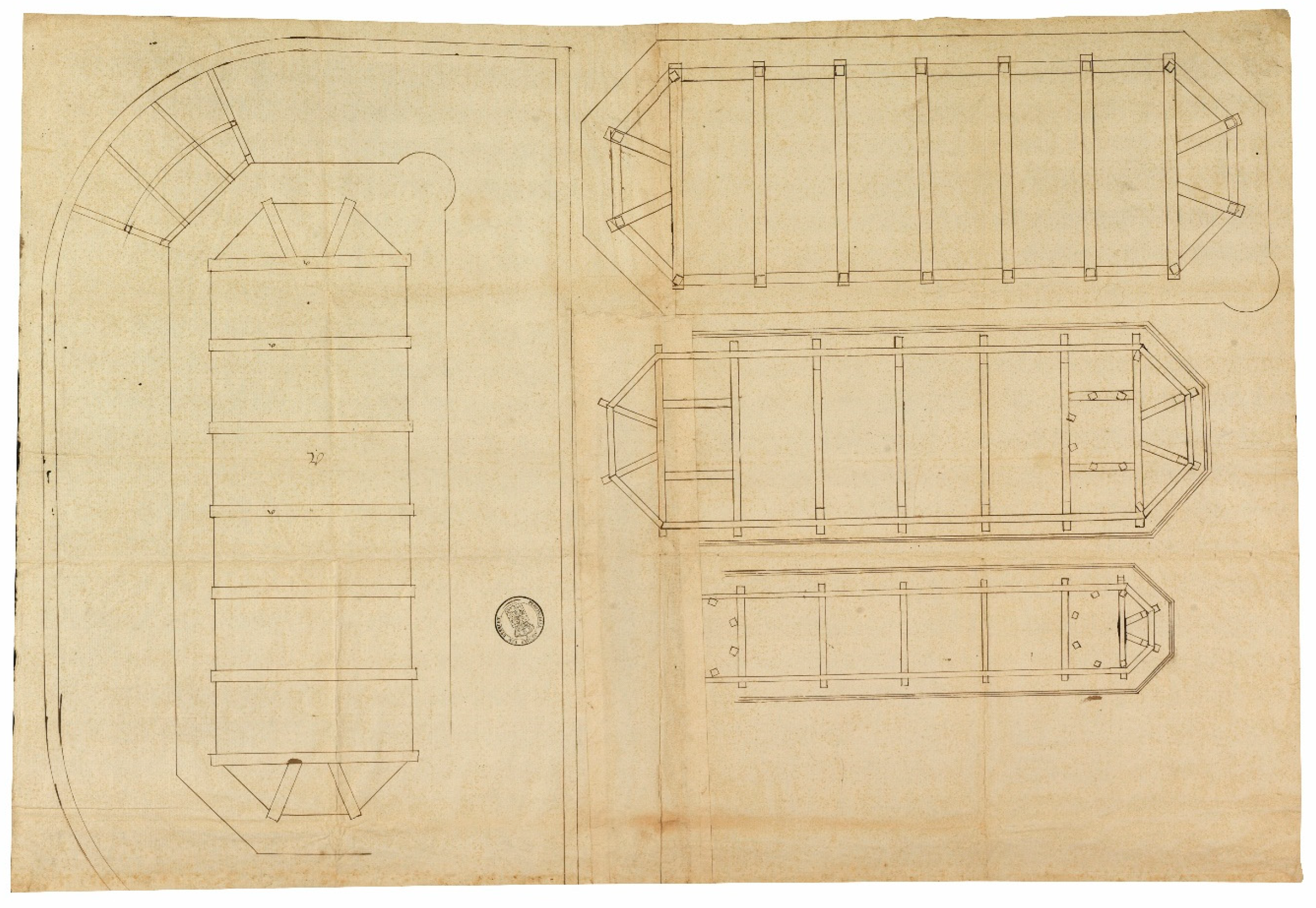
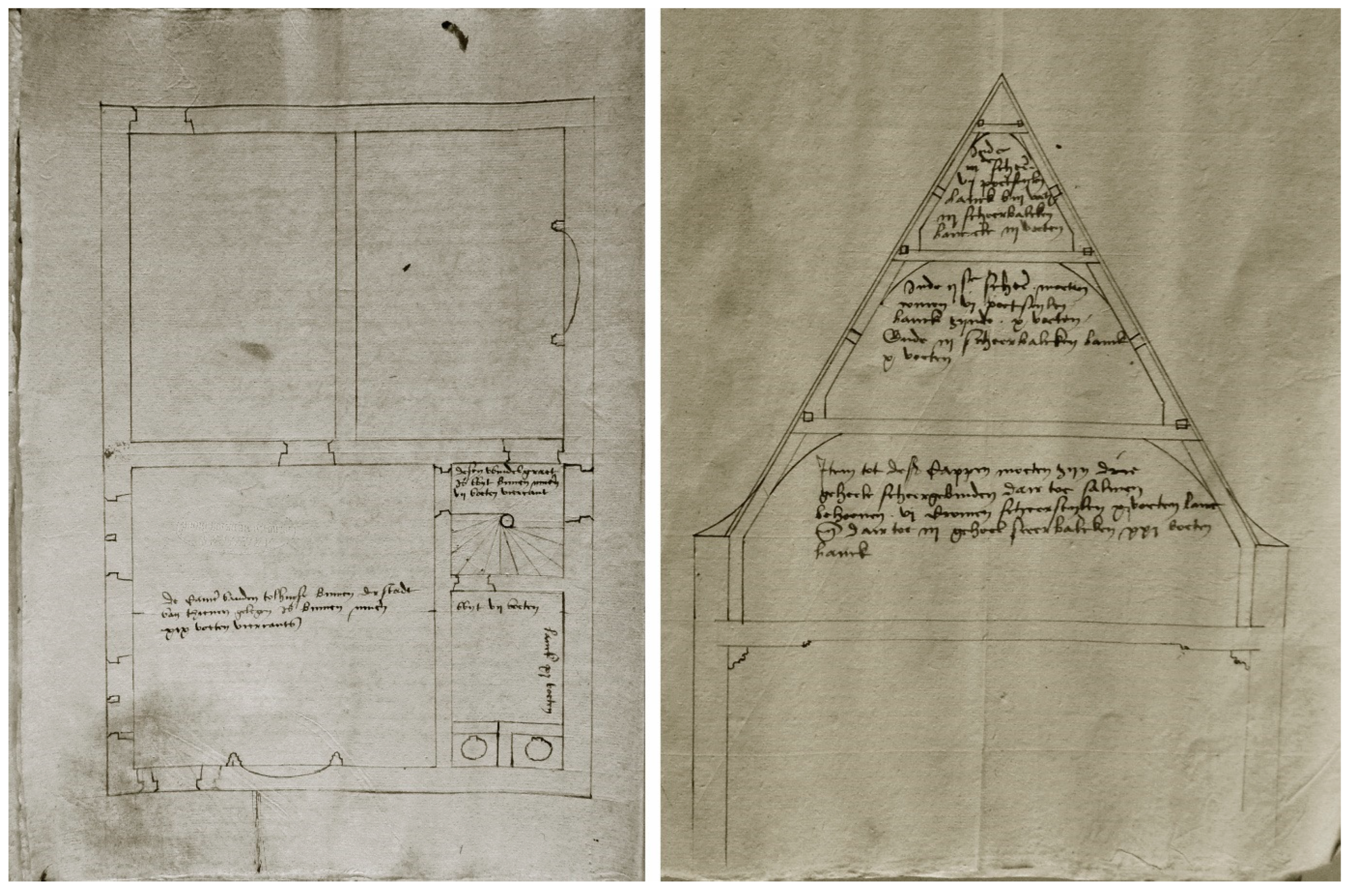
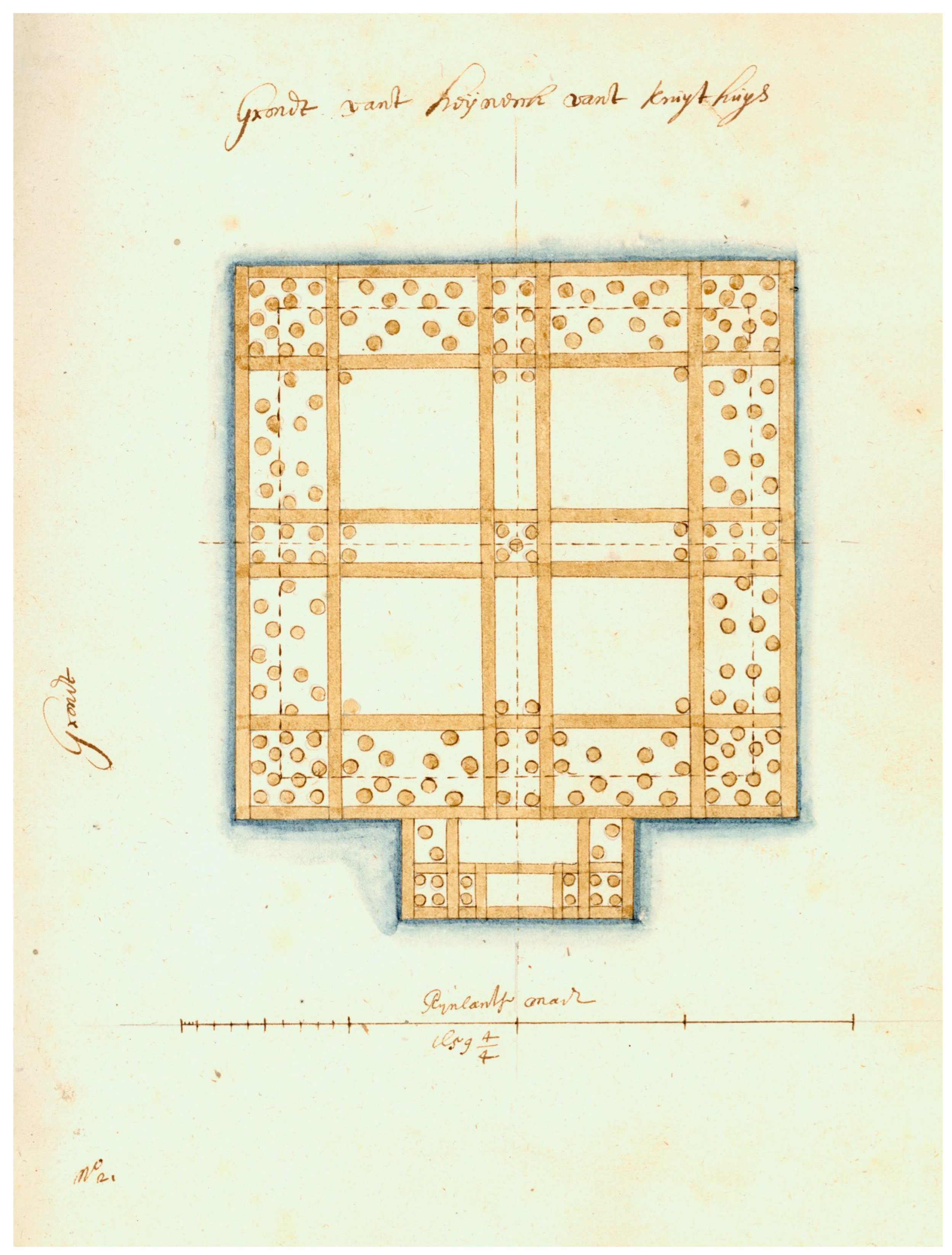
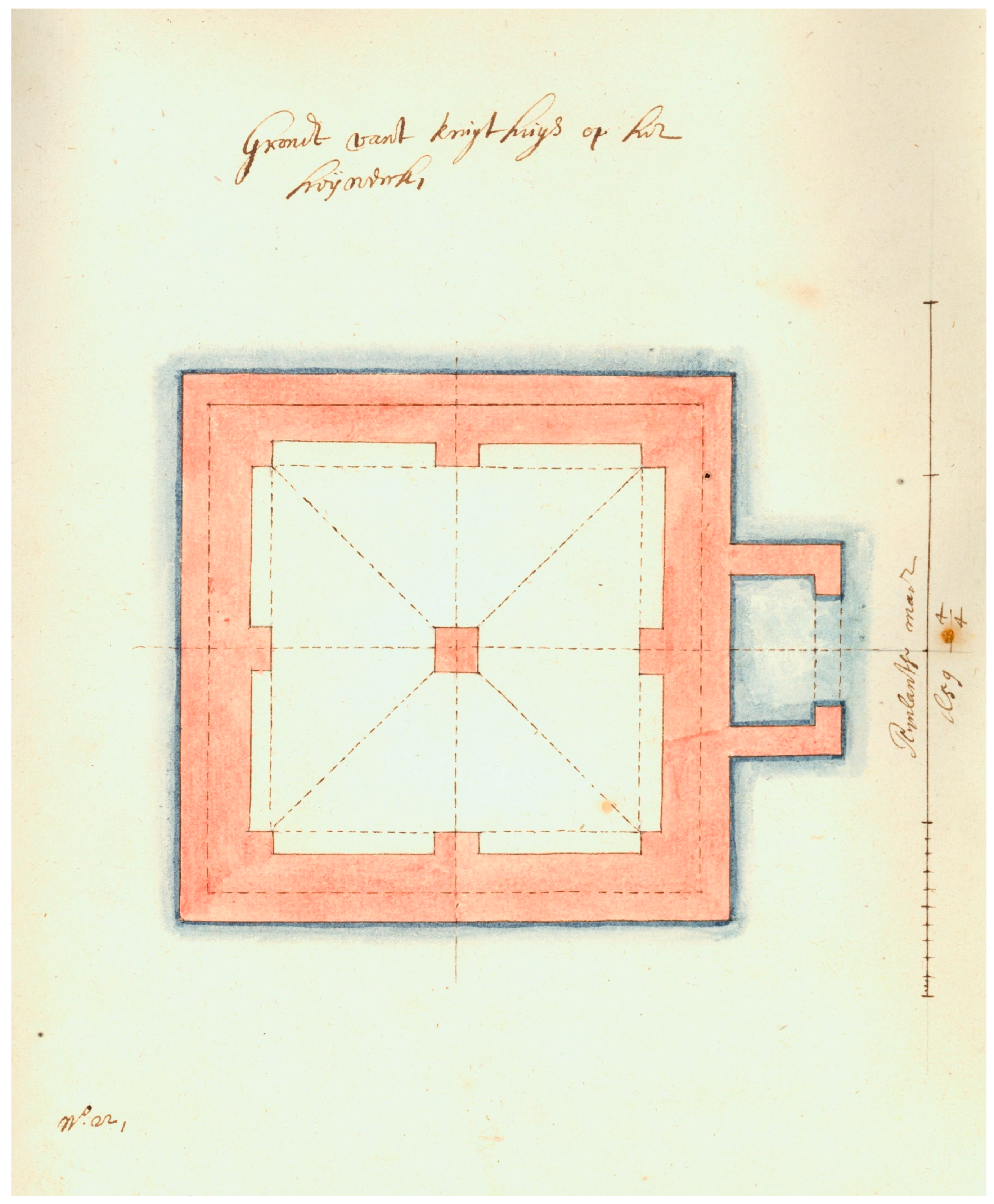
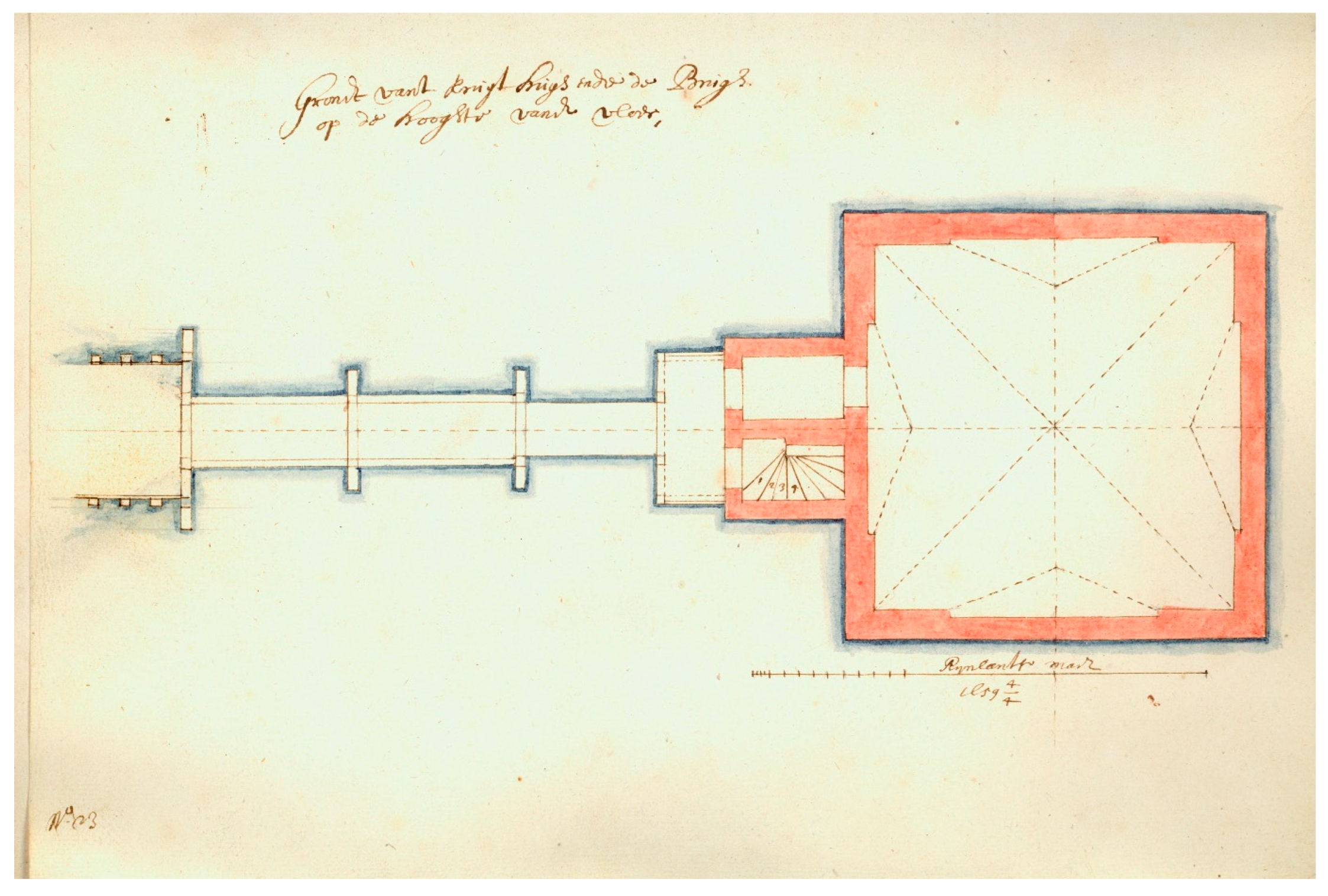


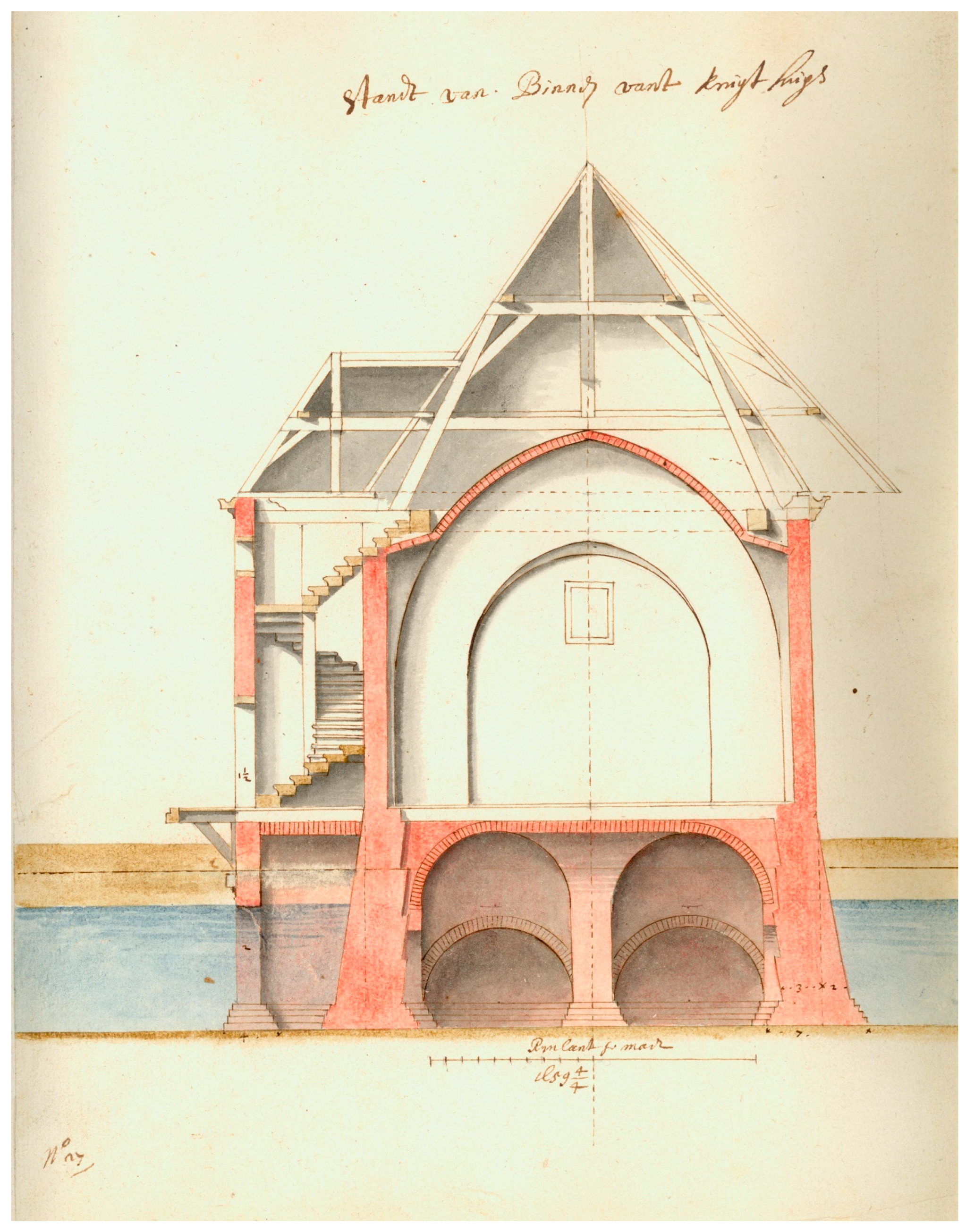
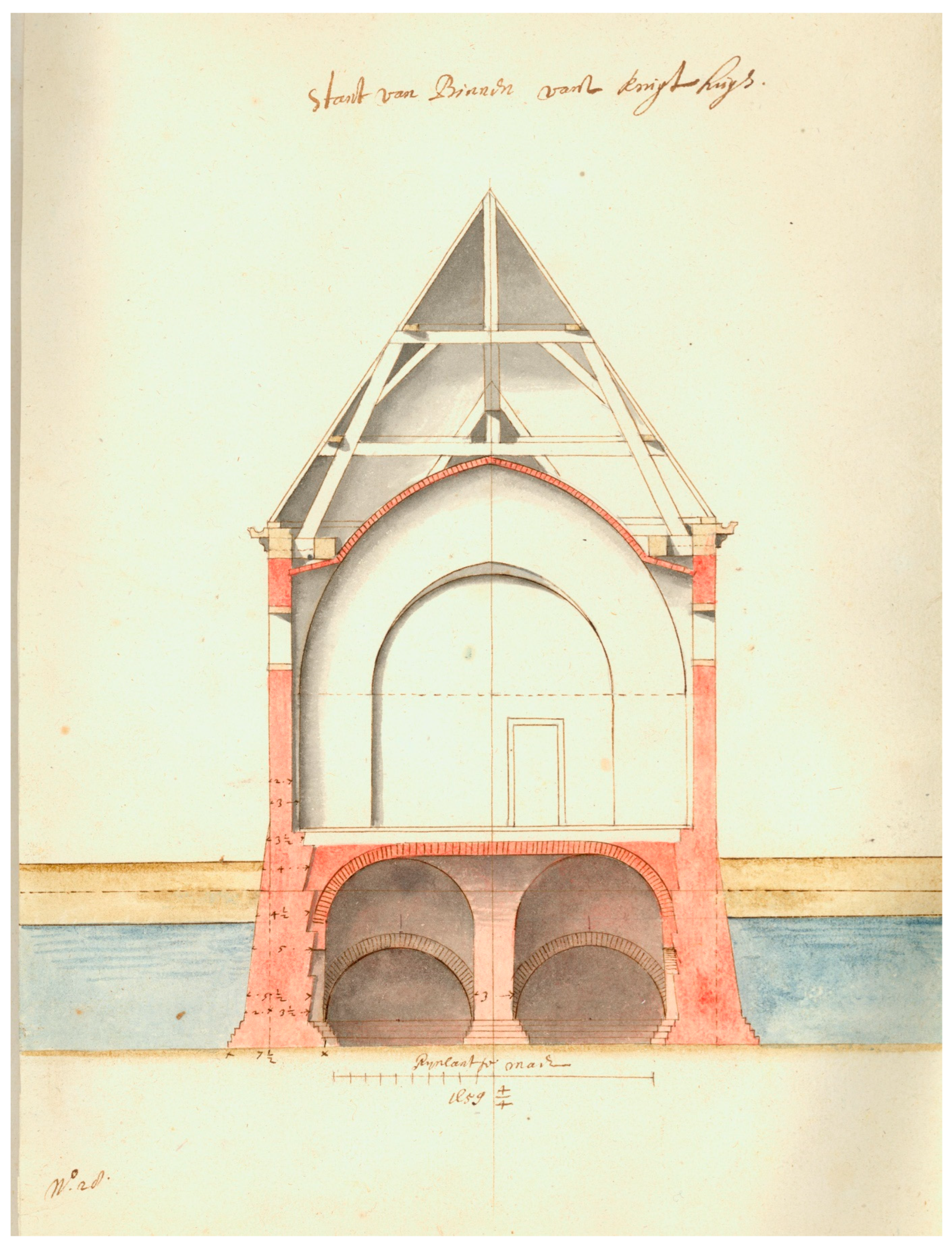
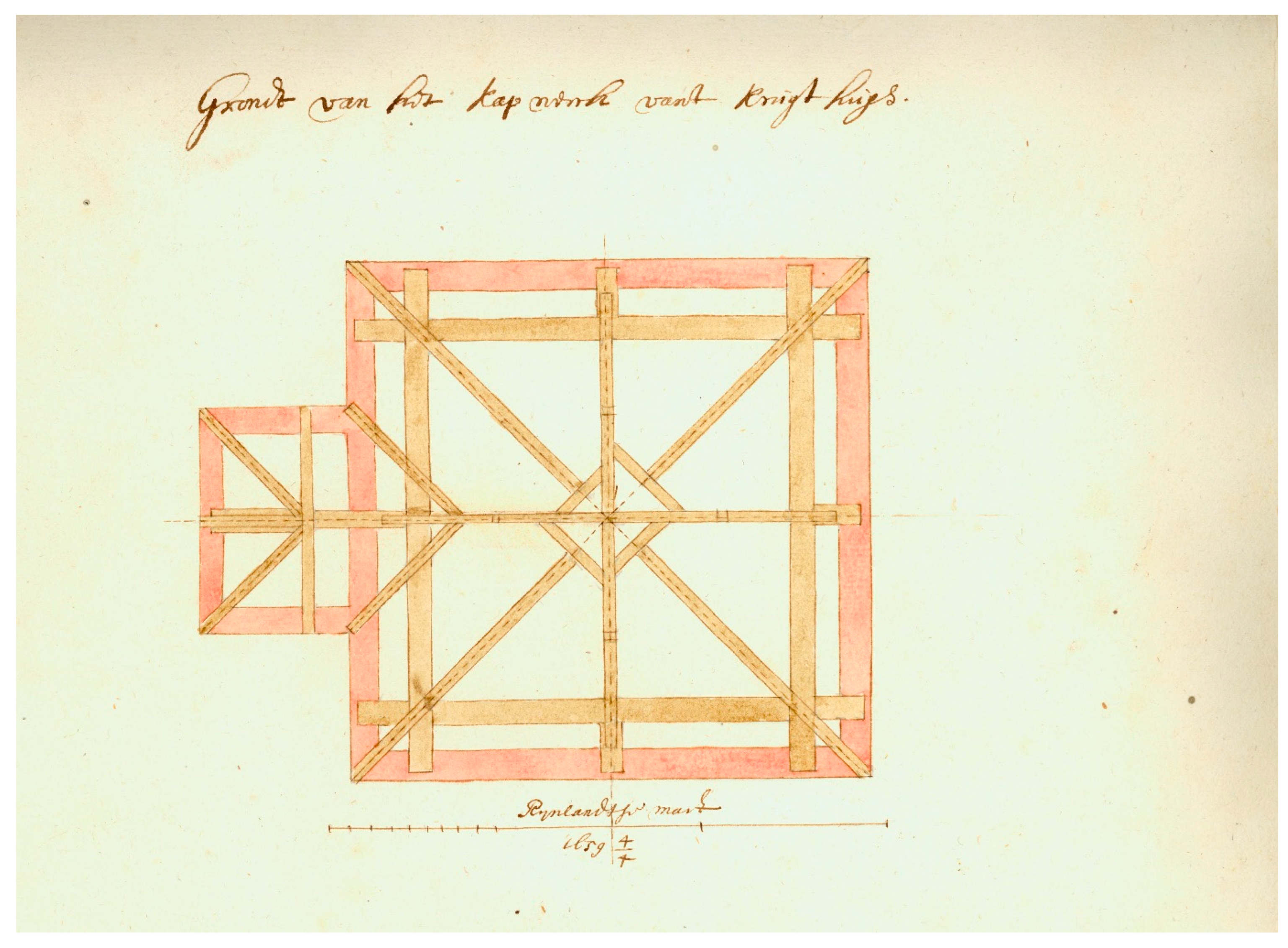
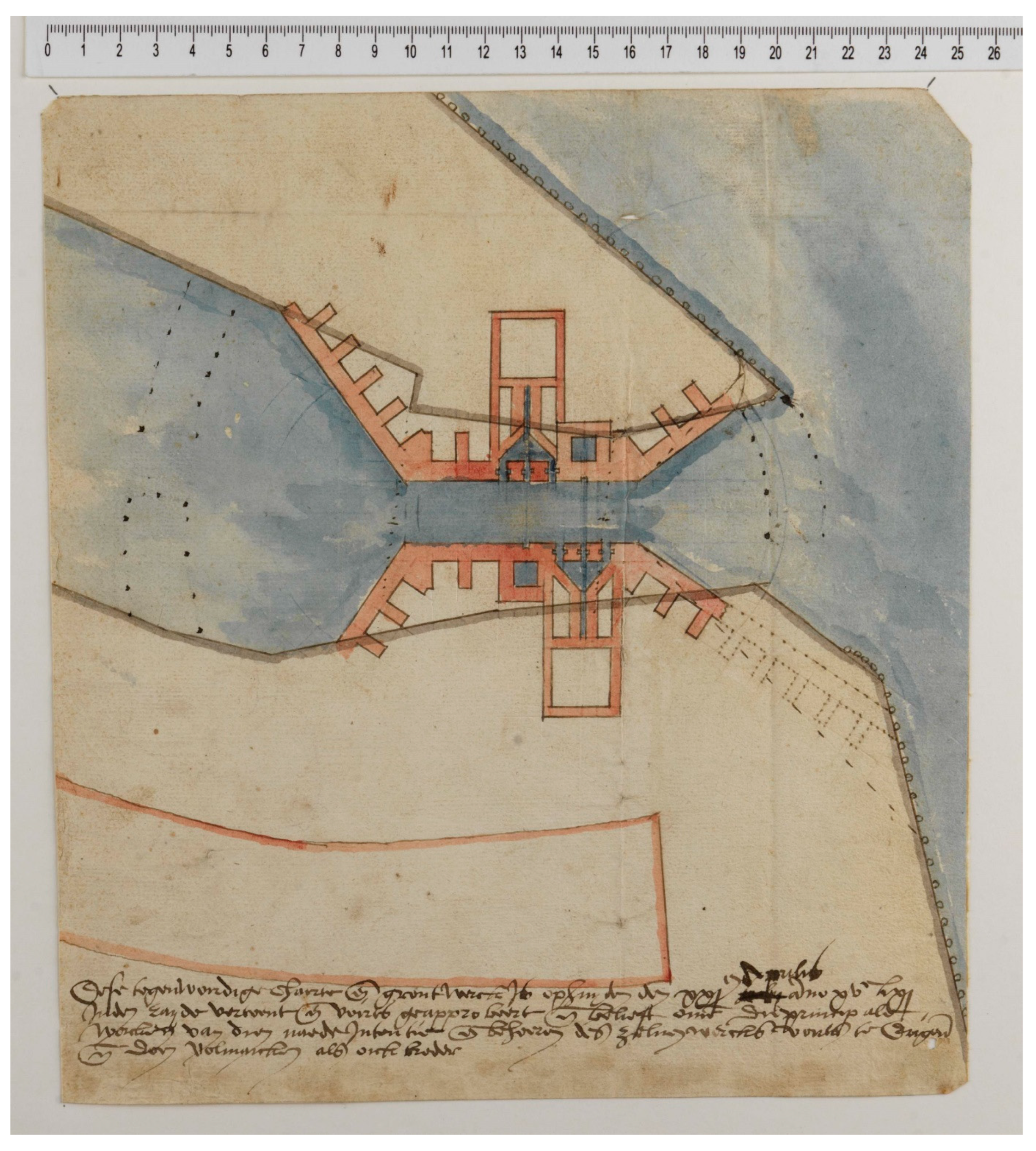


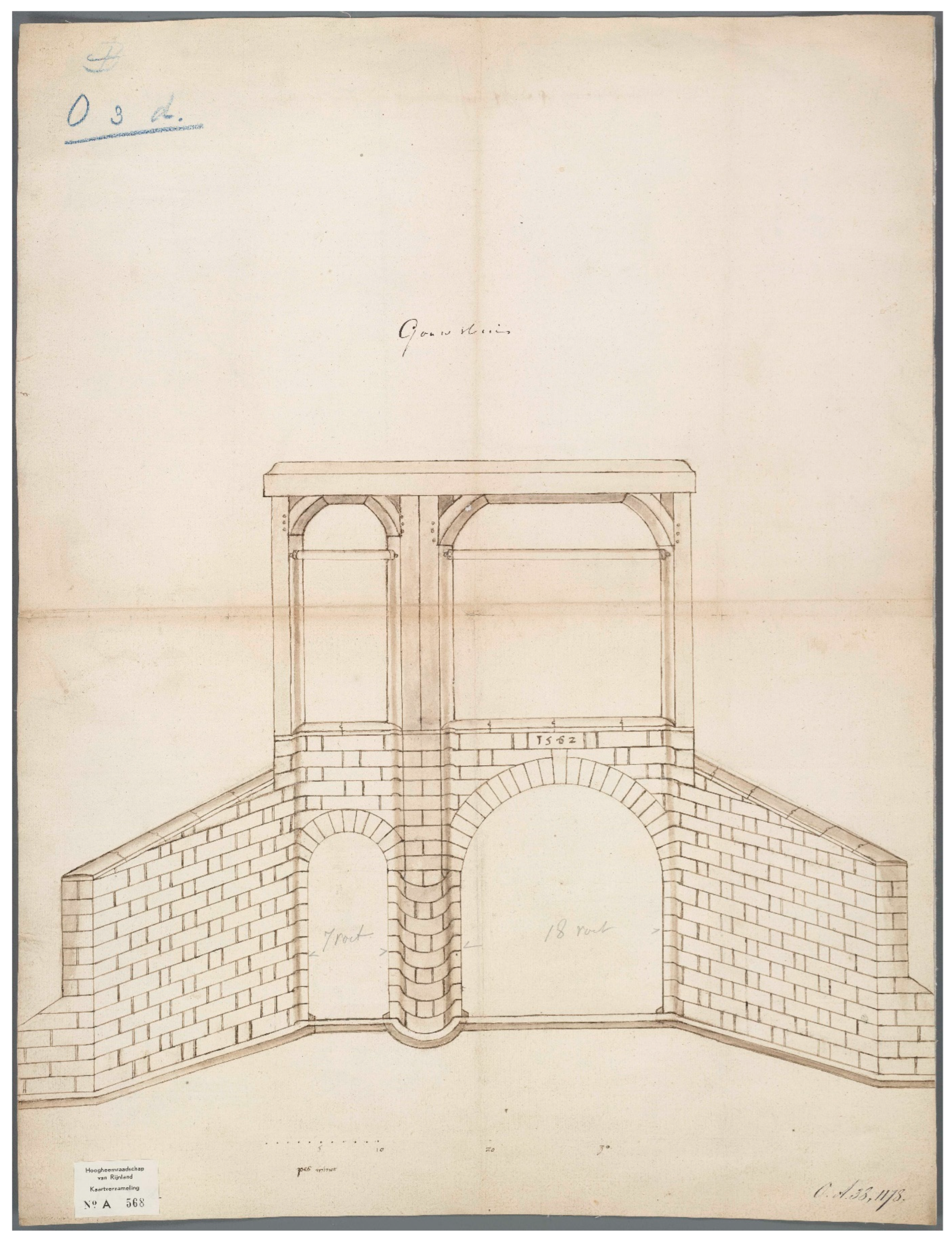
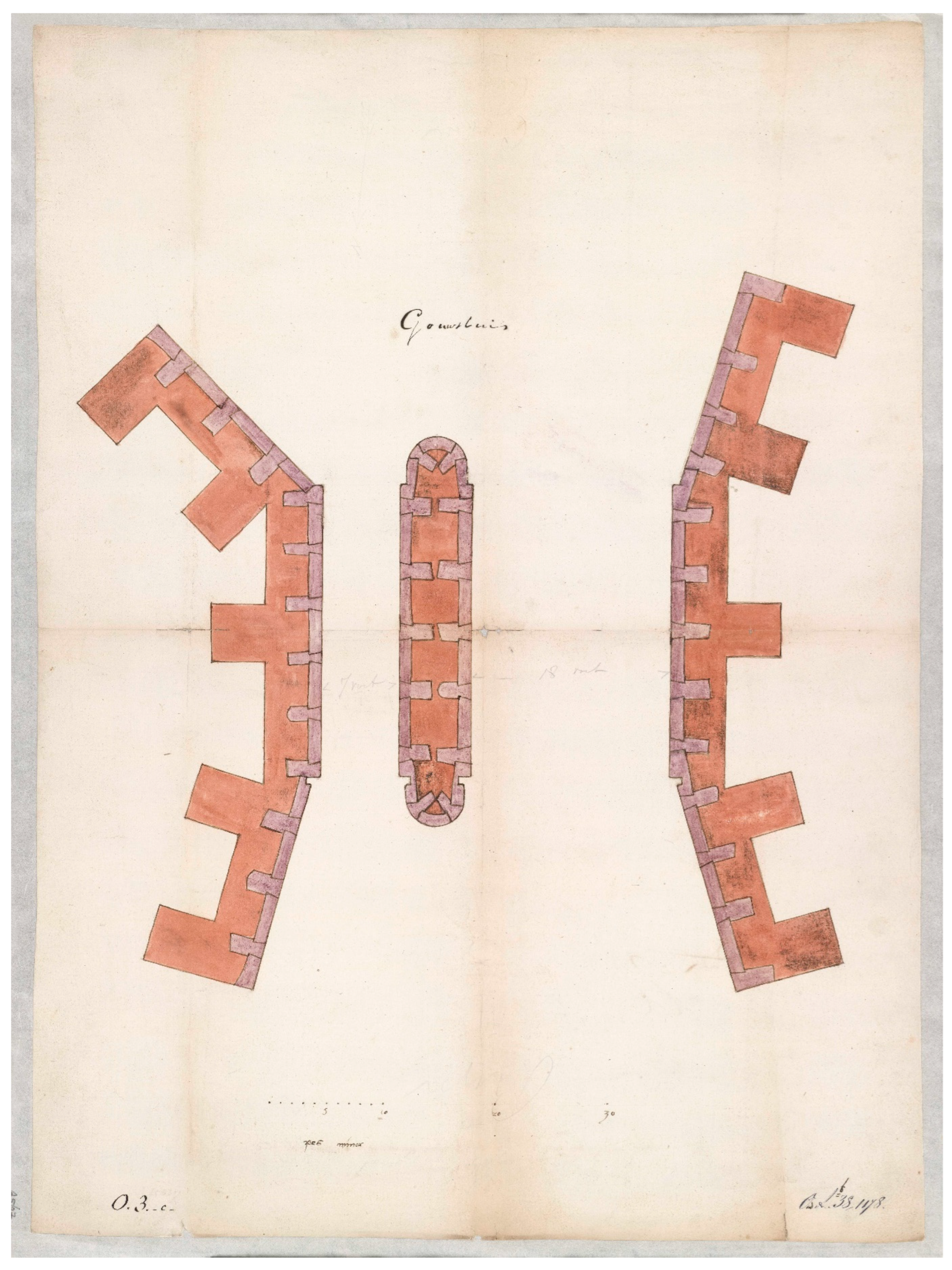
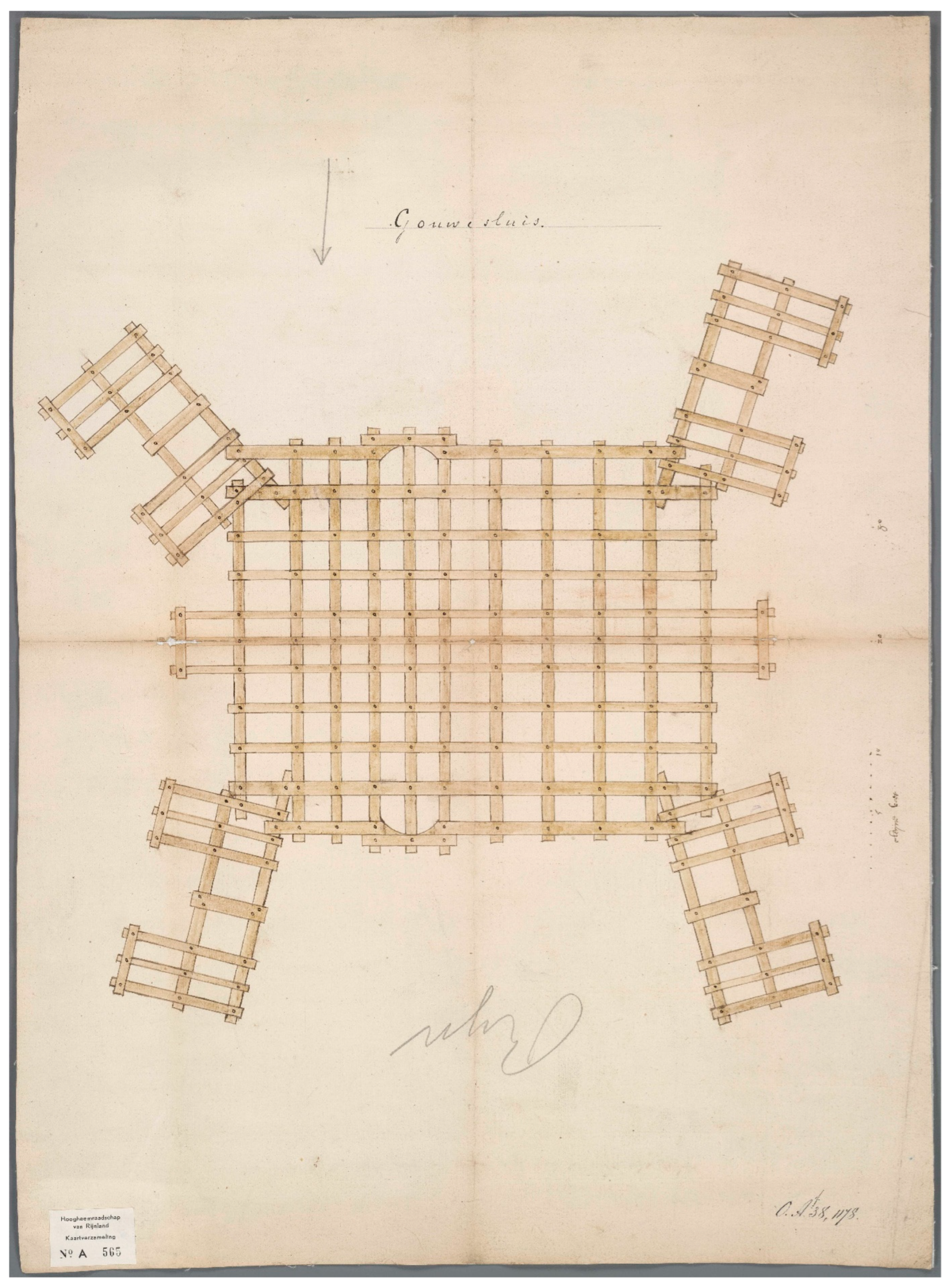

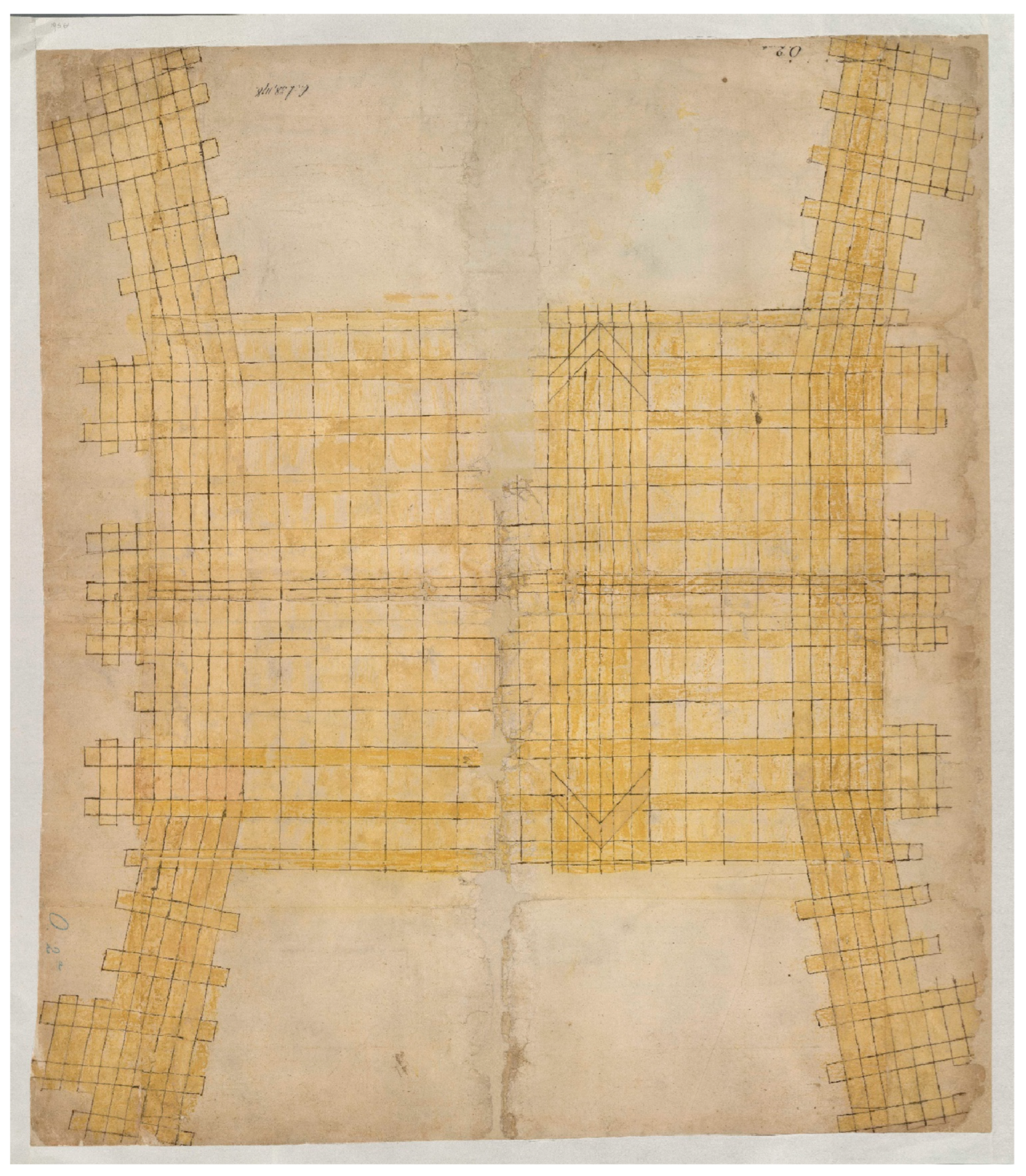
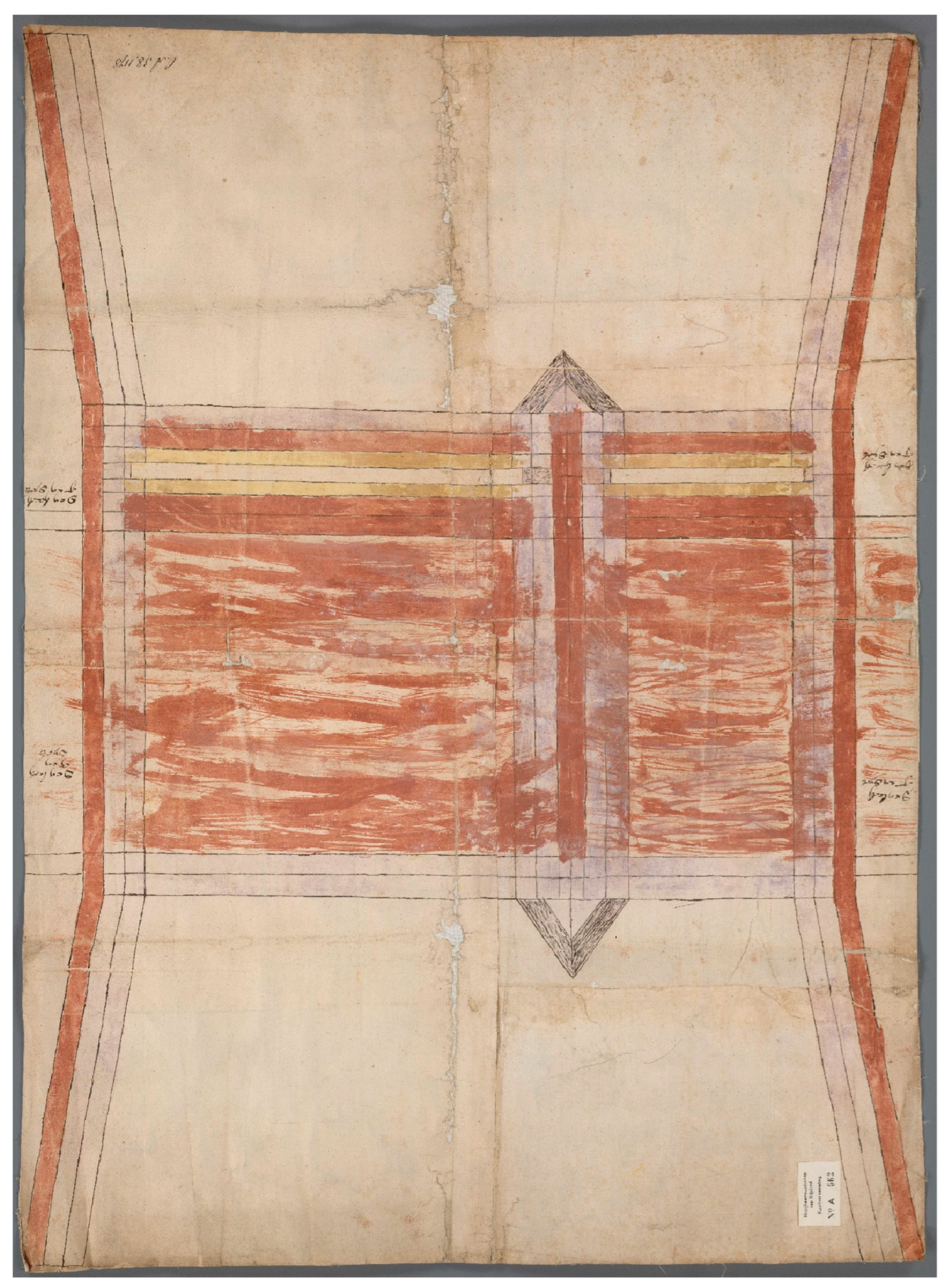
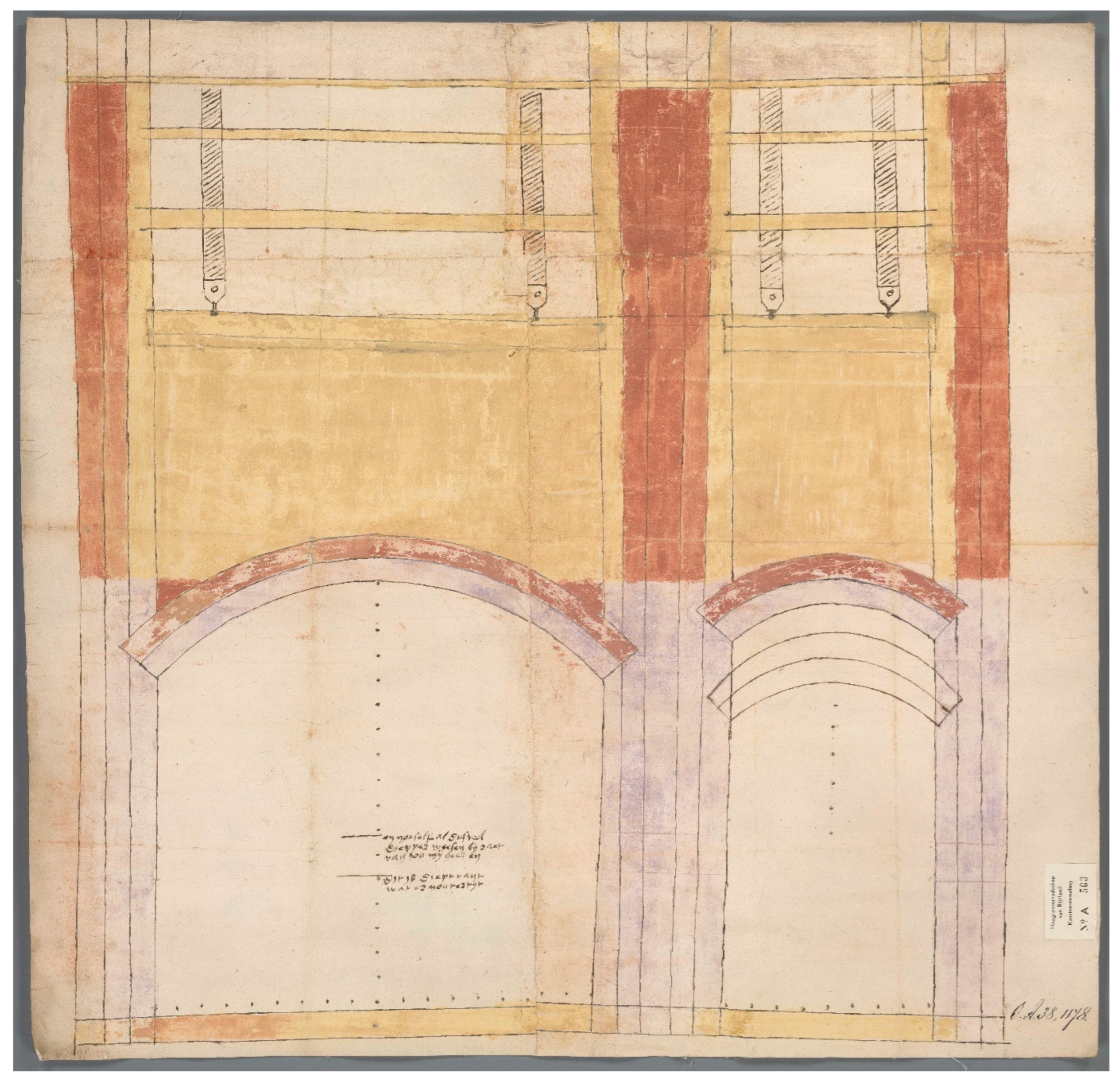
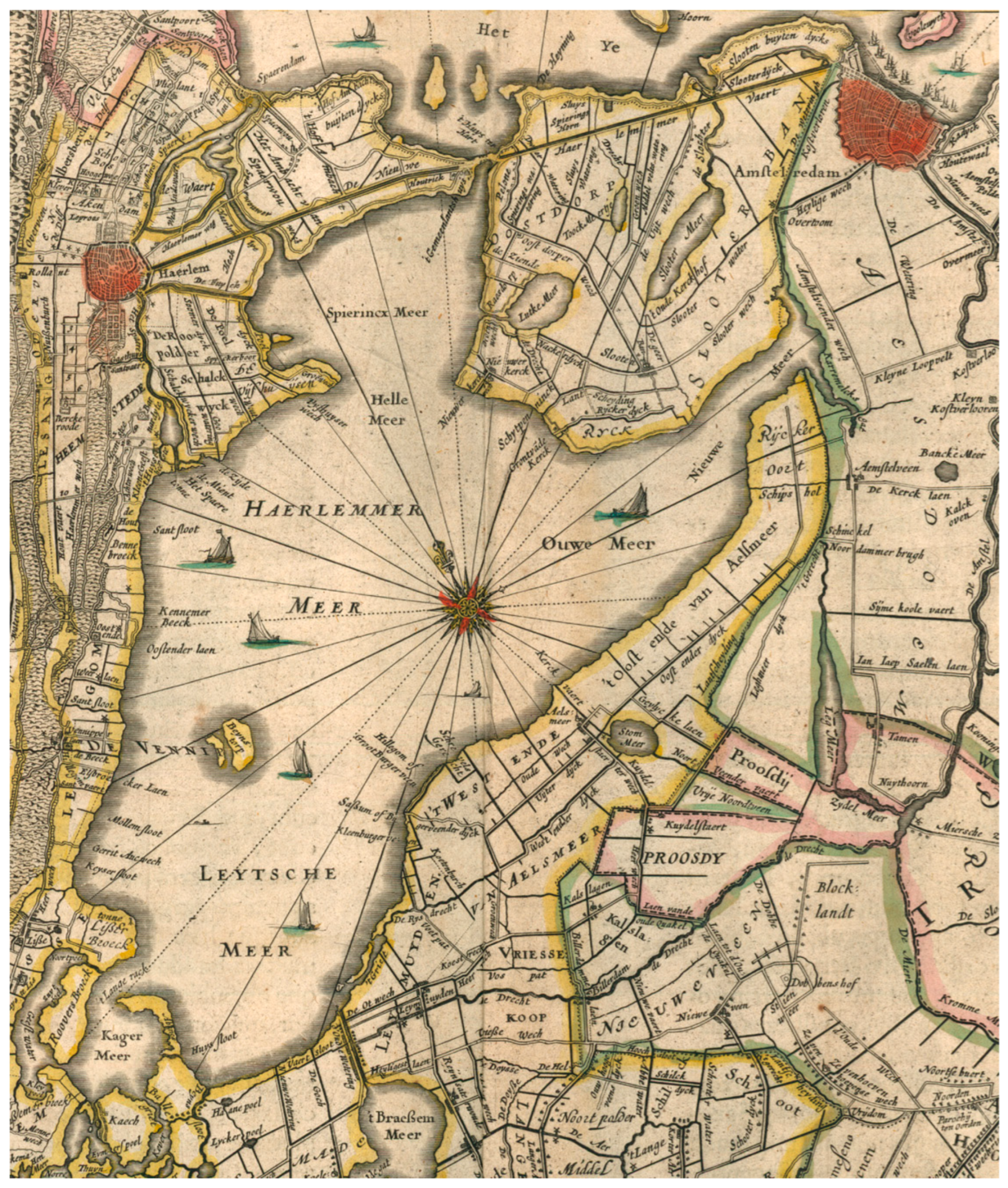
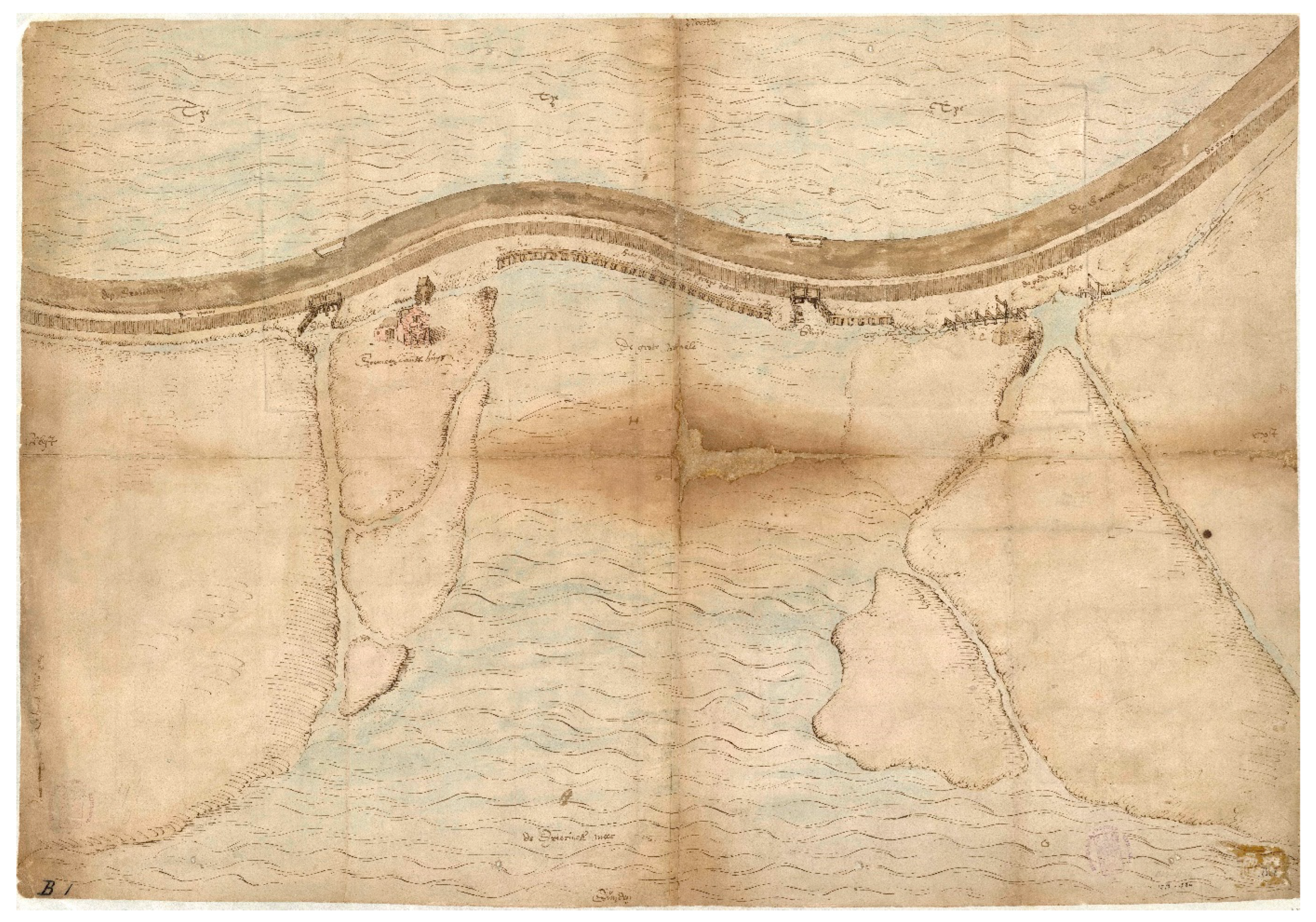





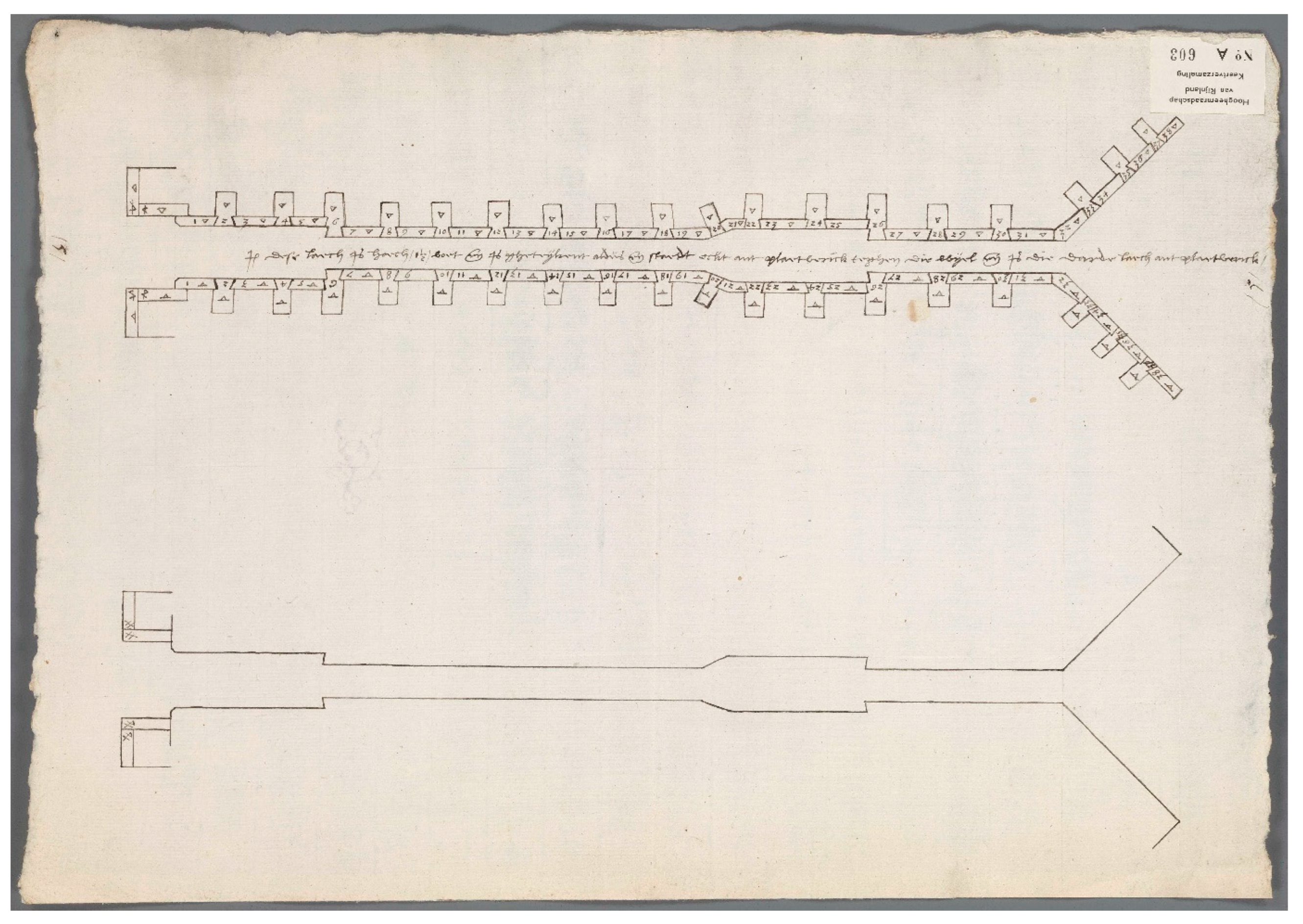
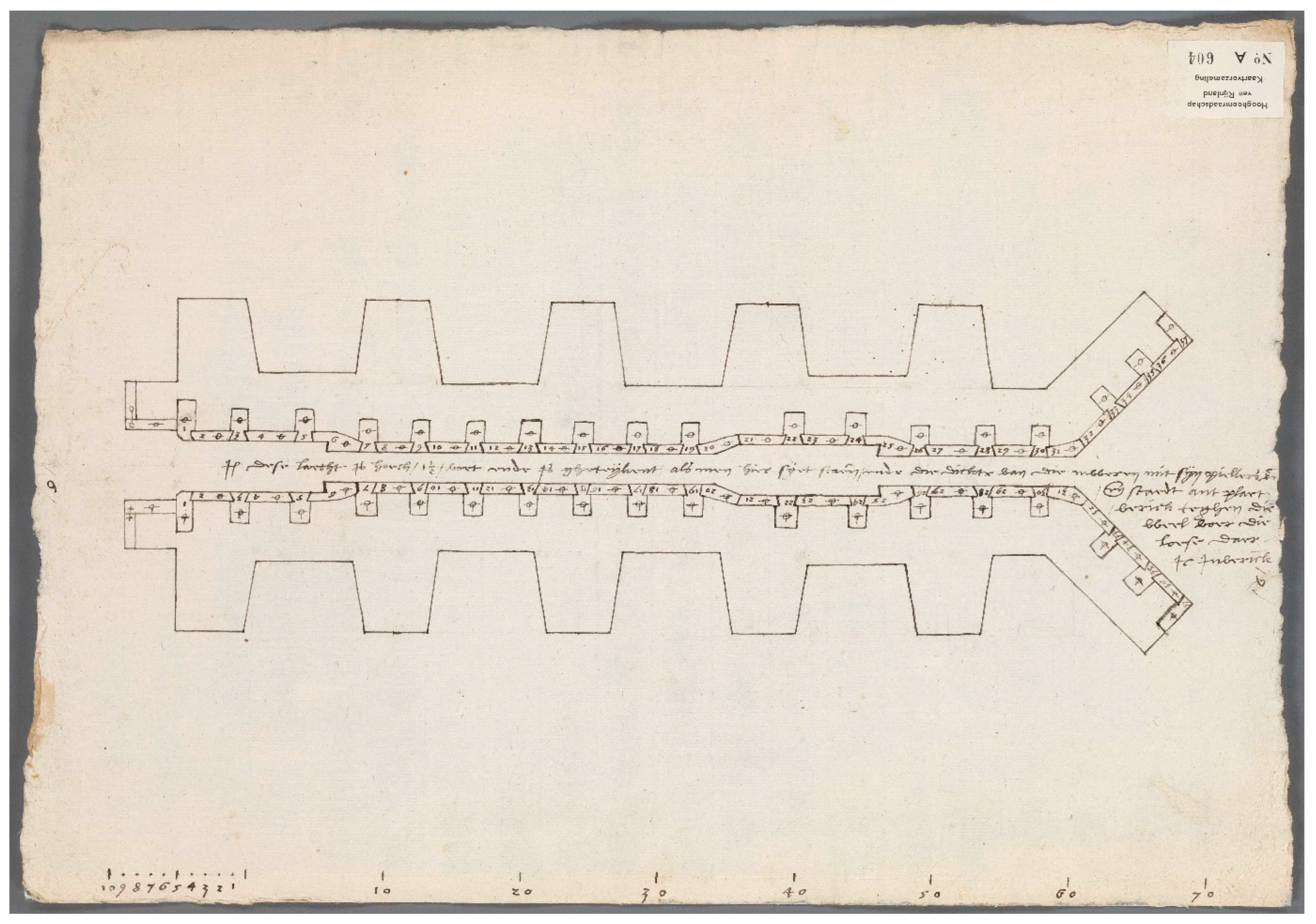


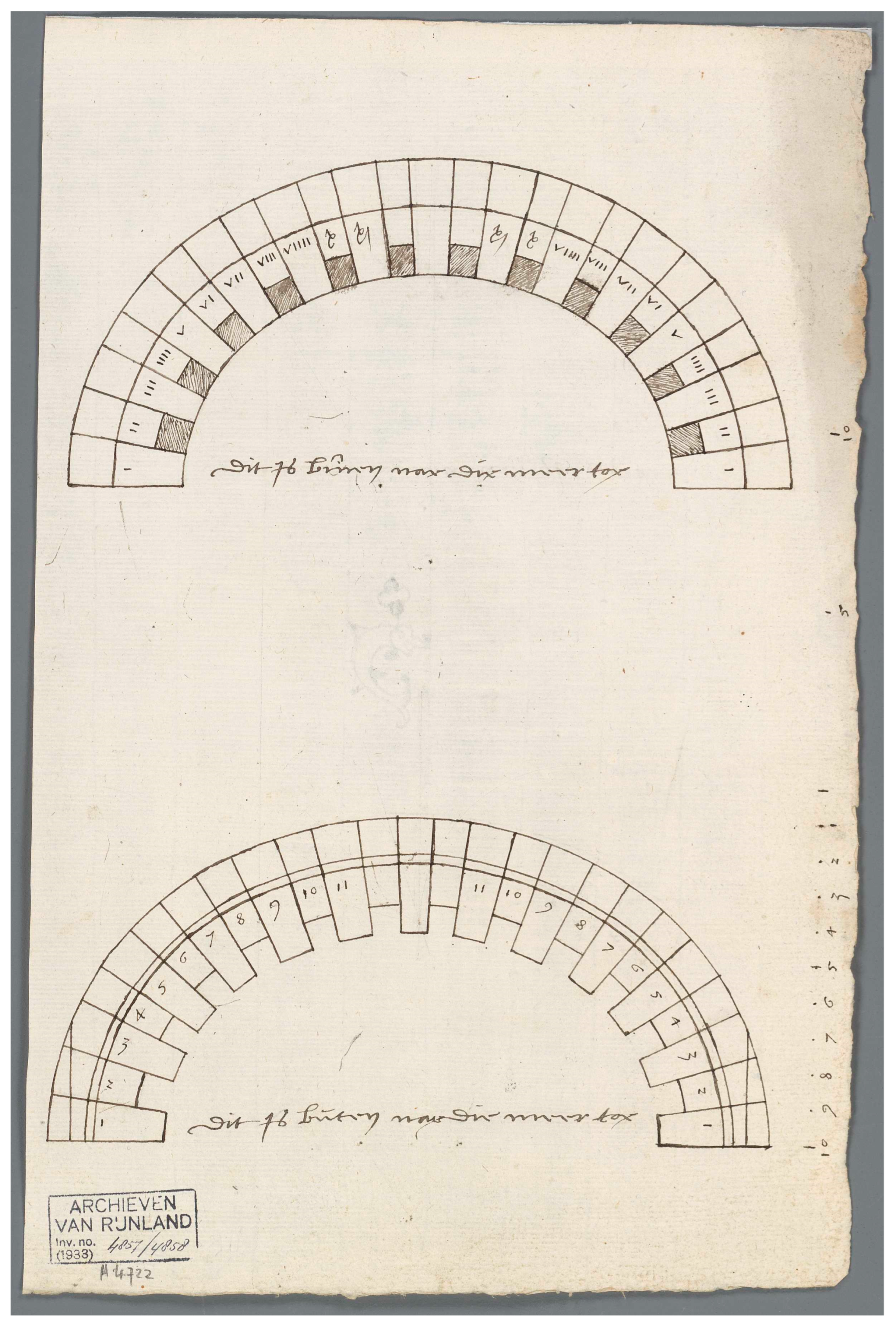
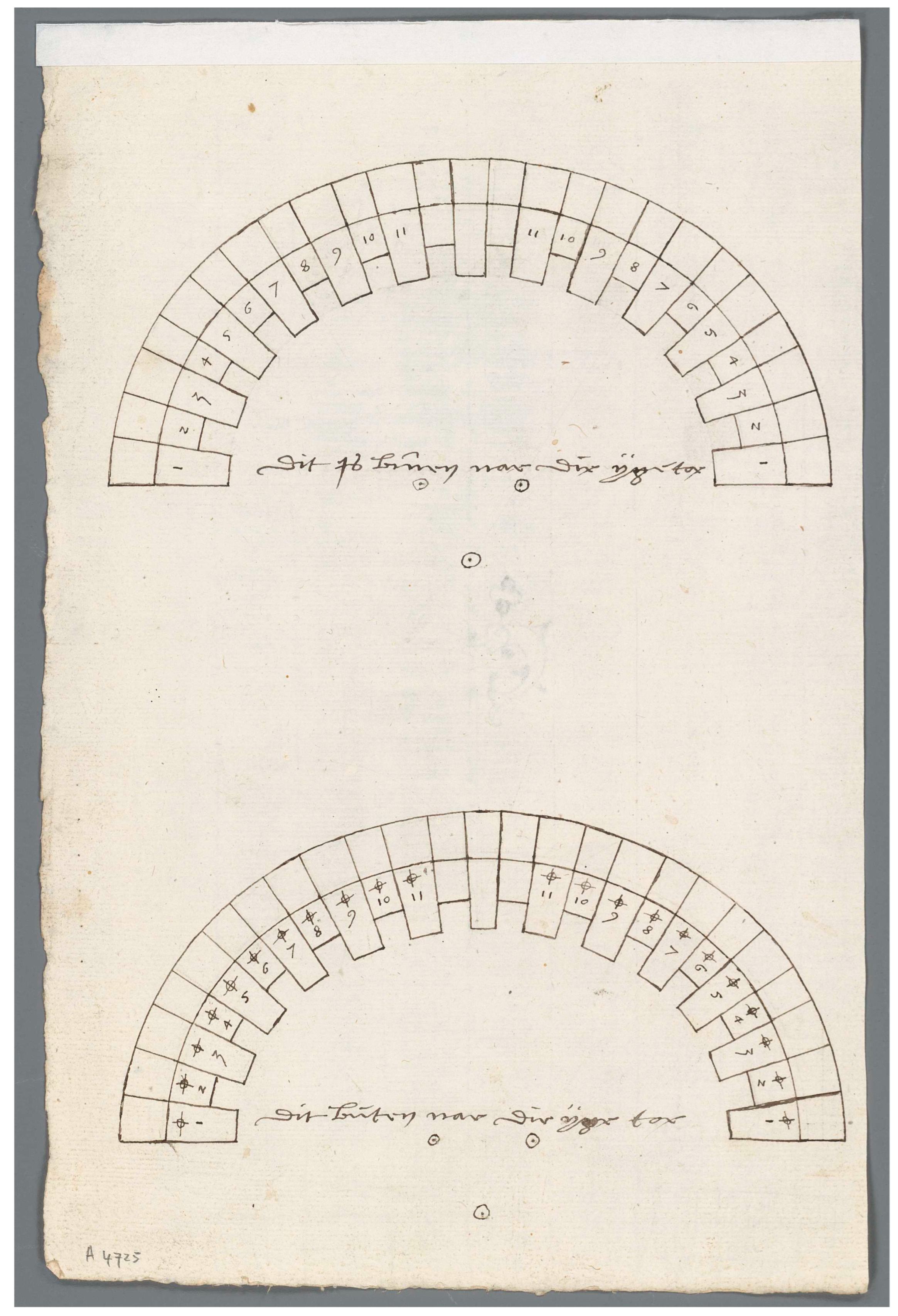
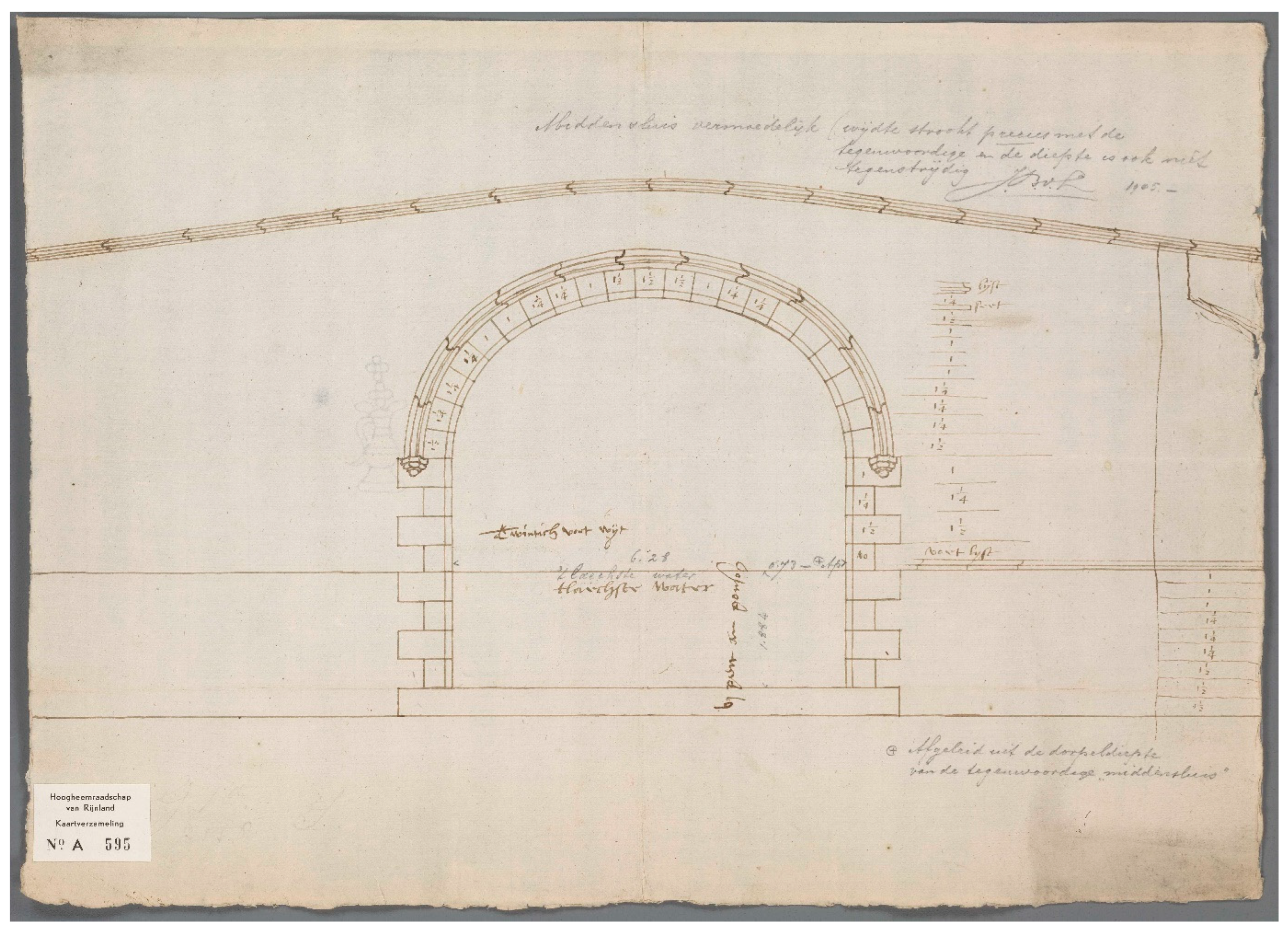
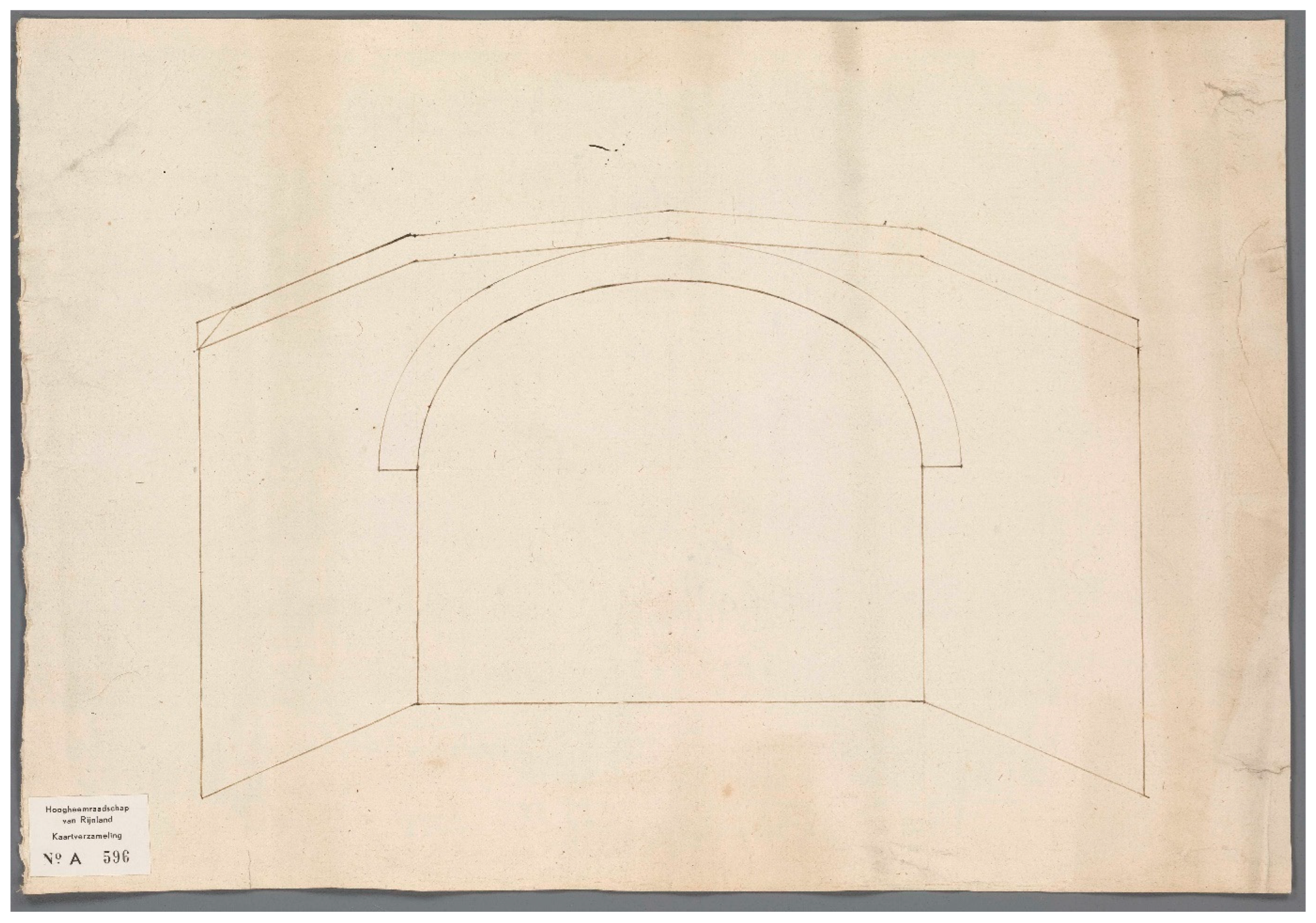

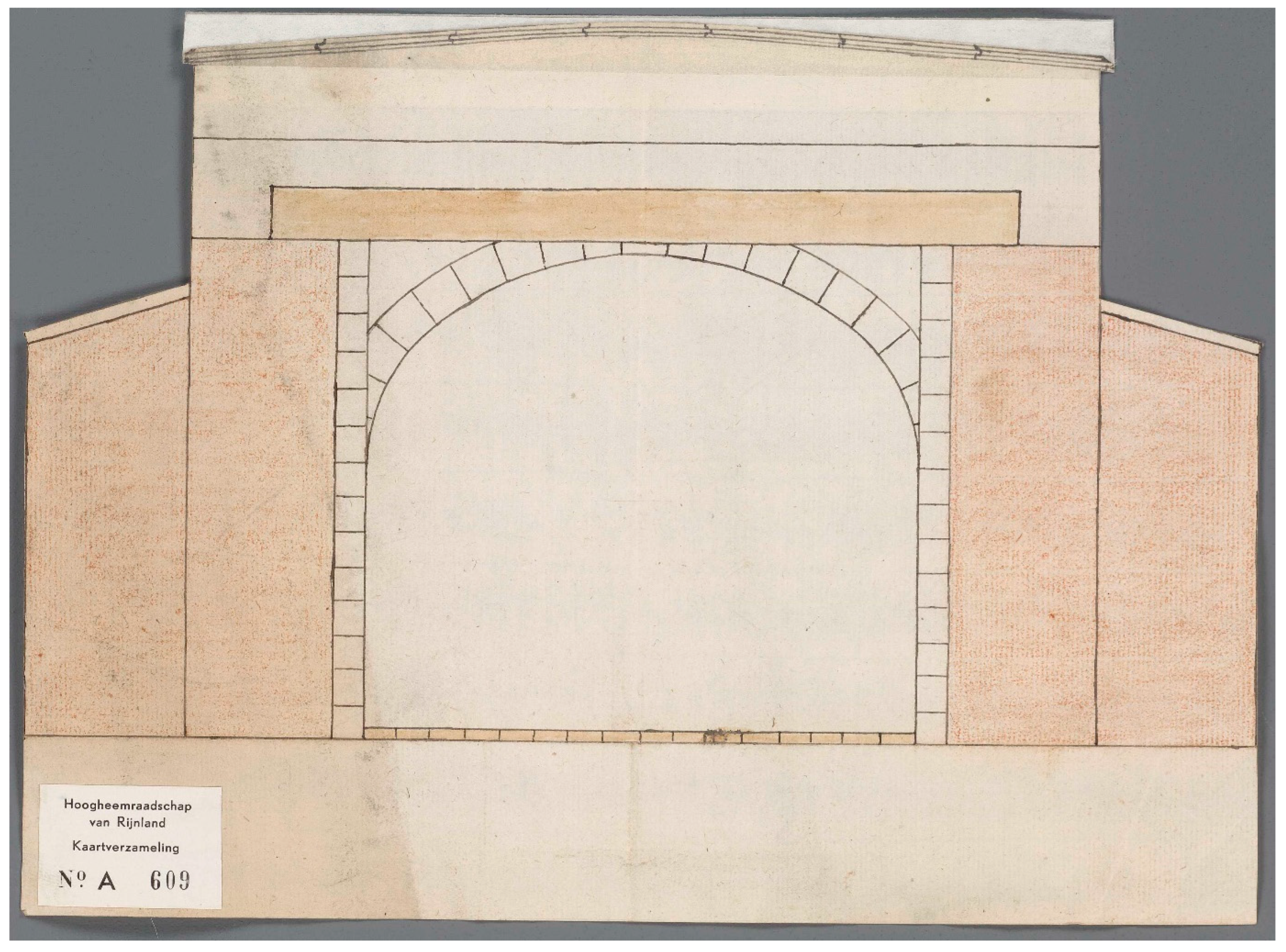


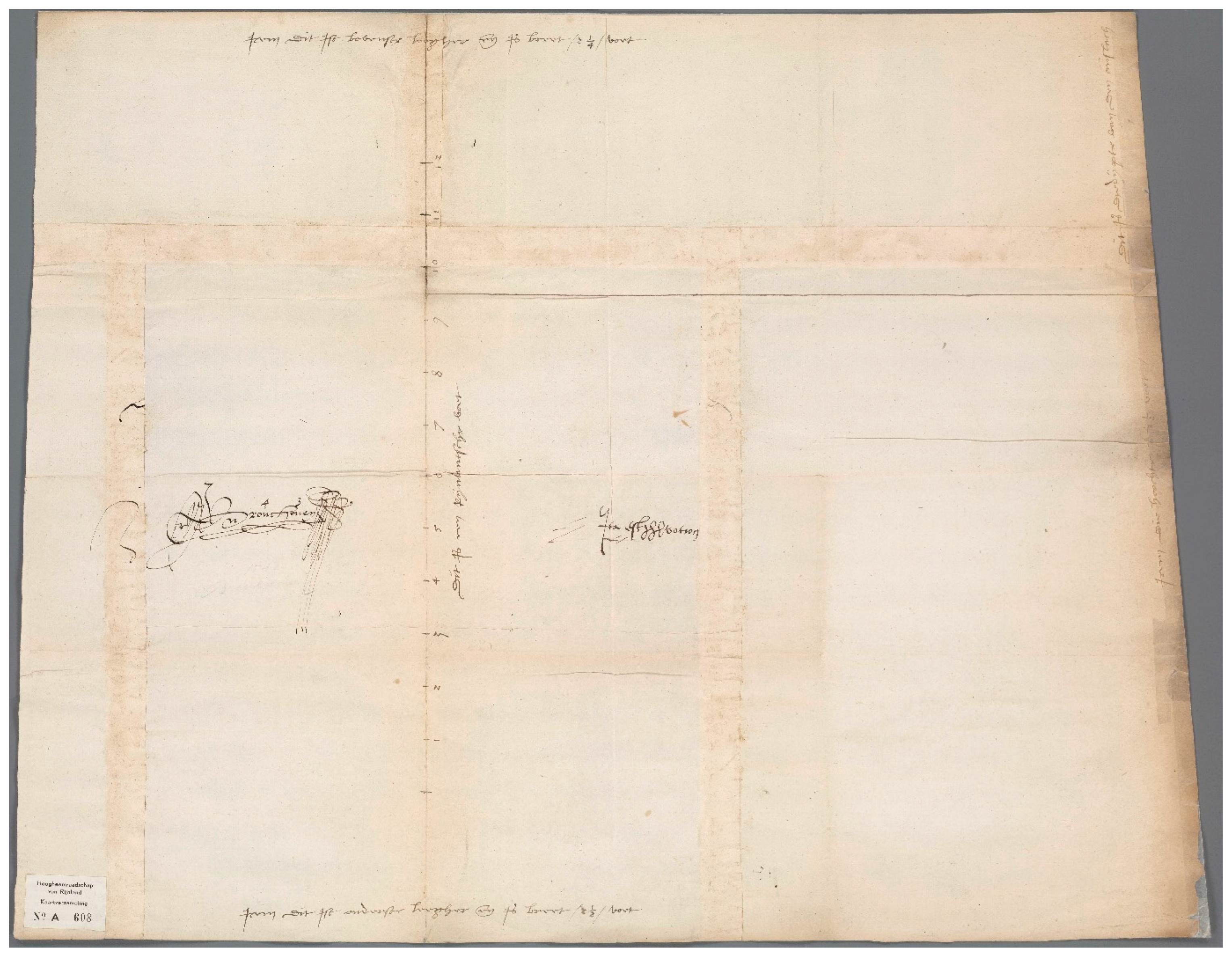
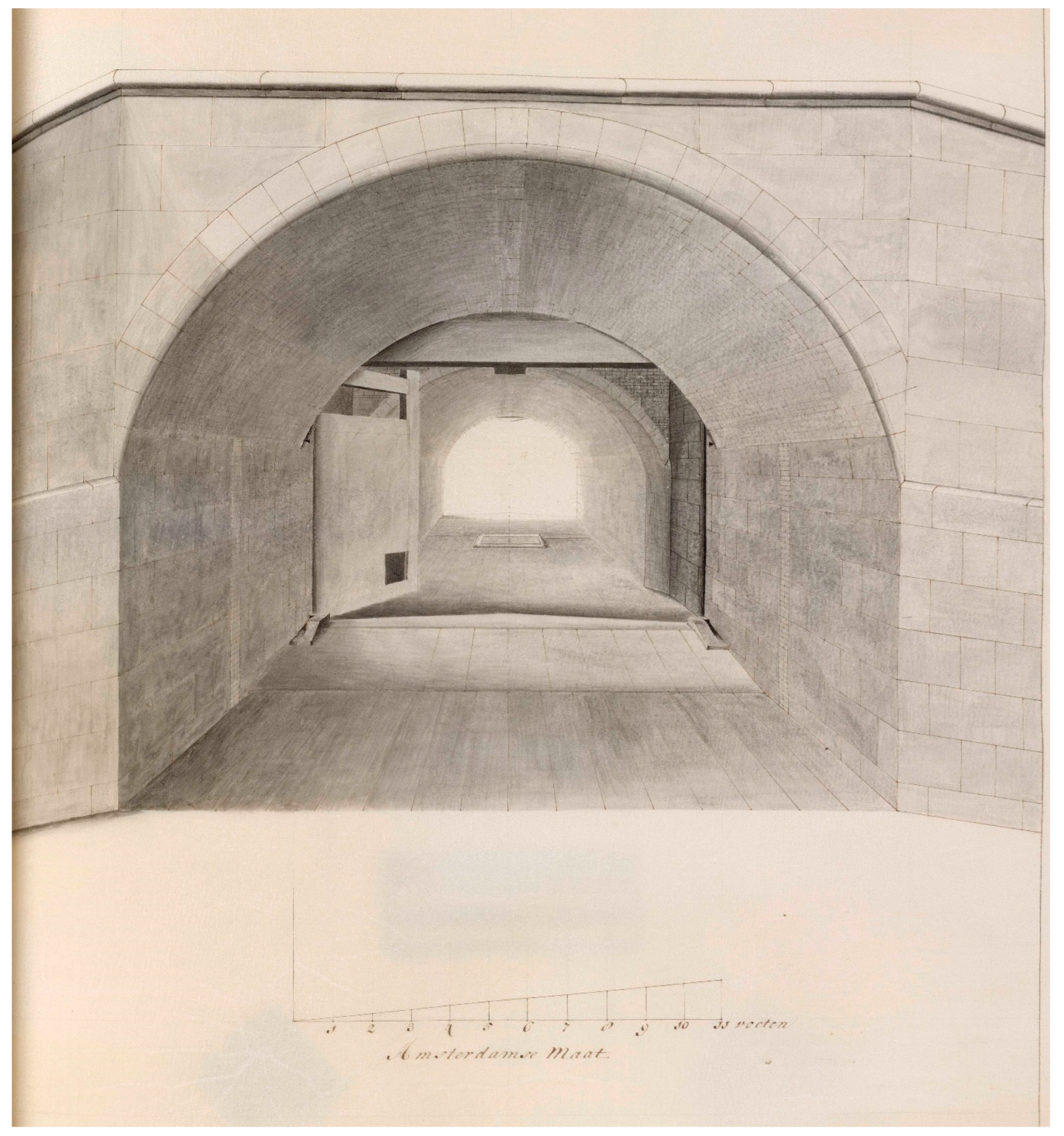

Disclaimer/Publisher’s Note: The statements, opinions and data contained in all publications are solely those of the individual author(s) and contributor(s) and not of MDPI and/or the editor(s). MDPI and/or the editor(s) disclaim responsibility for any injury to people or property resulting from any ideas, methods, instructions or products referred to in the content. |
© 2024 by the author. Licensee MDPI, Basel, Switzerland. This article is an open access article distributed under the terms and conditions of the Creative Commons Attribution (CC BY) license (https://creativecommons.org/licenses/by/4.0/).
Share and Cite
Hurx, M. Gothic Locks: Pioneering Drawings for Hydraulic Works in 16th-Century Holland. Arts 2024, 13, 151. https://doi.org/10.3390/arts13050151
Hurx M. Gothic Locks: Pioneering Drawings for Hydraulic Works in 16th-Century Holland. Arts. 2024; 13(5):151. https://doi.org/10.3390/arts13050151
Chicago/Turabian StyleHurx, Merlijn. 2024. "Gothic Locks: Pioneering Drawings for Hydraulic Works in 16th-Century Holland" Arts 13, no. 5: 151. https://doi.org/10.3390/arts13050151
APA StyleHurx, M. (2024). Gothic Locks: Pioneering Drawings for Hydraulic Works in 16th-Century Holland. Arts, 13(5), 151. https://doi.org/10.3390/arts13050151




